
- Poem Govert Huyser: Men of ten years and older
- Decorated Netherlands Indies (letter A) and Mauretz Christiaan Kokkelink
- Indonesians in the Dutch Resistance against the German occupier
- Netherlands Indies under Japanese occupation (Occupation, Oppression, Consolation girls, Internment (incl. religious on Borneo)
- Netherlands Indies (gays)
- 15 August and the war in South-East Asia (Hans Liesker and Peter Slors)
- Commemoration speech of dr. Bernard Bot, minister of Foreign Affairs of the Kingdom of the Netherlands (The Hague, 15 August 2005)
- Commemoration speech of prof. dr. B. Smalhout (The Hague, 15 August 2004)
- A dark page in the 400 year history of relations between The Netherlands and Japan (Japanese emperor in The Netherlands)
Also see Verhalen (stories):
Han Bawits and WW II
Ronald Scholte on Nagasaki
Camp notes by prof.dr. I.J. Brugmans
Memories by Friar Angelus
Experiences during the war by Max Tauran
Witness Jacob Litamahuputty
Also see the Antilles for the Japanese attack in 1941-1942 (Jan Willen van den Belt and Jan Frederik Haayen).
Men of ten years and older
The heiho flogged with well aimed lashes
Ten year old boys behind an army truck.
By incomprehensible decree they were
declared a man - and men
don't belong with their mother anymore.
He was in line with in his one hand his teddybear
clenched around the one paw left
In the other hand a bag with in it
The final bit of sugar and some malaria pills.
His mother put it in at last
He forced back his tears
After all, he was a man now.
His mother prayed and intensily hoped
To once see him again.
At his birth she had
thought of such a nice name for him.
She, she died of malnutrition and malaria
Lacked the pills that saved his life.
He ended up in a Dutch contract pension
Cold, wet, uncomfortable and not so nice either
The hunger winter was more important in conversations
Than his story of his – cruel - departure.
About good and evil he always thought differently
All his relations broke down
Booze and drugs sometimes helped, for a moment avoiding reality.
His career failed over and over
The only thing he missed was his old, one-armed, soft teddybear.
From: 'Fragments, memories of a camp boy', by Govert Huyser (2005). Publication made possible by financial support from the Military Victims of War and Related Purposes Foundation.
General b.d. G.L.J. Huyser (Surabaya 1931) stayed during the war in the Japanese internment camps 'Darmo' in Surabaya, 'Karangpanas' in Semarang and in the boys camp 'Bangkong' in Semarang.
Decorated Netherlands Indies (letter A) and M.Ch. Kokkelink
Civilians and military men and women from different groups in the Netherlands Indies, who were decorated for their behaviour during the war (only letter A)
For detailed information and the persons with the letters B to Z see www.onderscheidingen.nl
Aalbertsberg, Gerard. Born in Malang on 17 Februari 1908. Died in The Hague 6 April 1978. Resistance Star East Asia 1942-1945, Resistance Commemorative Cross. Journalist
Abdoel Sakoer. Bronze Cross. Native servant, on board of the destroyer Hr.Ms. 'Piet Hein'
Abdullatif-Nji Raden [noble title] Enong Tjitjik, Mrs. Resistance Star East Asia 1942-1945. Civilian from Bandoeng
Adjoen (alias Pang Linggan). Bronze Lion. Native civilian, involved with the underground resistance in the Netherlands Indies
Adriani, Paulus Lambertus Grimmius. Born in Makasser on 17 January 1914. Died on board of the Hr.Ms. Hydroplane 'X29' near Soerabaia on 11 February 1942. Flyers Cross. Officer-pilot 2nd class Navy Aviation Service, on board of the Hr.Ms. Hydroplane 'X29'
Agerbeek, Jacques Rola. Born Batavia on 21 March 1880. Died in Koepang on 17 August 1942. Resistance Star East Asia 1942-1945. Capitain of Infantry-titulair ret. from the Royal Netherlands Indies Army, authority of the Home Guard
Akoeilia Torey. Bronze Cross. Native civilian, member of the resistance in the Netherlands Indies
Akolo. Bronze Cross. Ambon sergeant 2nd class from the Royal Netherlands Indies Army
Alan. Bronze Cross. Native kampong leader, member of the resistance in the Netherlands Indies
Aliet, Hendrik. Born in Paleleh, Makassar, on 20 August 1912. Died in Monrovia, Los Angeles in March 1983. Resistance Star East Asia 1942-1945. Soldier with the Coast Artillery of the Royal Netherlands Indies Army
Alstede, Paulus Simon. Born in Buitenzorg (Bogor, Java) on 20 June 1906. Died on board of the Hr.Ms. Cruiser 'Java' in the Java Sea on 27 February 1942. (also see Jan Frederik Haayen at The Netherlands Antilles). Bronze Cross, War Commemorating Cross, Officers Cross XV. Lieutenant-at-sea 1st class, navigation-officer on board of Hr.Ms. Cruiser 'Java'
Altman-de Moet, Mrs. Lena Cornelia (“Corrie”). Born in Malang on 1 September 1911. Died in Benidorm on 24 April 1996. Married on 11 June 1929 in Amsterdam to Friedrich Heinrich Altman. Divorced in Djakarta on 20 May 1952. Resistance Star East Asia 1942-1945. Civilian in Soerabaja
Amag Darminah. Resistance Star East Asia 1942-1945. Town head of the dessa Pengantap, district Geroeng, West-Lombok
Amag Lebih. Resistance Star East Asia 1942-1945. Town head of the dessa Bengkok, district Geroeng, West-Lombok
Amag Redam. Resistance Star East Asia 1942-1945. Town keeper of the dessa Pengantap, district Geroeng, West-Lombok
Amag Sibah. Resistance Star East Asia 1942-1945. Town head of the dessa Blangas, district Geroeng, West-Lombok
Amahorseja, M.B.. Bronze Cross. Sergeant-telegrapher of the Royal Navy
Amak. Cross of Merit. Servant, on board of the m.s. 'Madoera'
Amat. Bronze Cross. Native civilian, member of the resistance in the Netherlands Indies
Ament, Cornelus Carolus. Born in Paroendjaia, Java, on 29 March 1896. Executed in Batavia-Antjol on 23 September 1943. Resistance Star East Asia 1942-1945. Employee of the General Agricultural Syndicate
Aroen. Bronze Cross. Native inland boy, with the Submarine Service of the Royal Navy
Asbeck, Thomas Karel baron van. Born in Kedongdjati (Java) on 14 October 1899. Died in The Hague on 23 October 1966. Knight in the Order of the Dutch Lion, Officer in Order of Orange Nassau and many other decorations. Officer in the Order of Orange-Nassau owing to: “Under difficult and often dangerous conditions in a competant and tactical way commander of our Escort vessel ‘JAN VAN BRAKEL’ and before of our Minelayer ‘VAN MEERLANT’ during over three years. capitain-lieutenant-at-sea, commander of Hr.Ms. Escort vessel 'Jan van Brakel'
Asjes, eng. Dirk Lucas. Born in Soerabaja on 21 June 1911. Died in The Hague in February 1997. Military Willems Order, Knight in the Order of the Dutch Lion, Flyers Cross and many other decorations. Military Willems Order owing to: “Distinguished himself during battle by excellent deeds of courage, tact and loyalty by during the period from 27 February 1944 until 22 September 1944 taken part personally in an exemplary way in a large number of operational flights of the Netherlands Indies 18th Squadron bombers from Australia to the by the enemy occupied area in the South Moluccas, on Timor and Flores and on islands in the Banda Sea and the Arafoera Sea, as well as on New-Guinea...”
Ayal-Nahuwae, Costavina ("Coosje"). Born on 15 April 1926. Cross of Merit, Resistance Commemoration Cross, Honorary Token for Order and Peace, Mobilisation-War Cross, Badge Wounded. Civilian. Cross of Merit owing to: "Acted brave and very meritorious during many months of guerilla fights against the Japannese in the Vogelkop-area of New-Guinea, and sharing all dangers and hardships of the guerrilla-fighters."
Source: www.onderscheidingen.nl
Mauretz Christiaan Kokkelink
Born in Willem I (Netherlands-Indies) on 17 June 1913. Died in French-Guyana in August 1994. Temporary fuselier at the KNIL (26-03-1931), militian soldier KNIL (09-12-1941), milition sergeant KNIL (01-01-1944), temporary mil-aaoi KNIL (09-08-1945), e.o. 20-07-1950 KB K.310. Author of the book 'Wij vochten in het bos - de guerillastrijd op Nieuw-Guinea tijdens de Tweede Wereldoorlog' (We fought in the woods - the guerilla war in New-Guinea during World War II). Knight 4th class of the Military Willems-Order; K.B. no. 17 of 12 april 1945. Militia-sergeant of the KNIL.

The Willemsorder was awarded to him with the following motivation:
"Initially as an under-commander, later on as commander of a detachment starting 58 men strong, after the occupation of Manokwari at New-Guinea by the Japanese in March 1942, showed great courage, tactful actions, perseverance and capability. Whilst having moved to the inland during the Japanese occupation, despite indescribable problems and hardships, during 2½ years brought the largest possible damage to the enemy, therefore even forcing Japanese authorities to put a prize of 10.000 guilders and a large portion of rice and salt on his head and sending out a force of 1100 Japanese soldiers to destroy his guerilla-gang. Still weak and ill, after reporting himself back to the Dutch authorities, immediately offering himself again for very risky tasks."
N.B.: M.Ch. Kokkelink is added because of his high decoration
Source: www.onderscheidingen.nl
N.B.: Also see the Netherlands Indies born marine Frans Meeng (section Suriname, A group of marines from Suriname, the Antilles and Netherlands Indies). He received the War Remembrance Cross with buckle for 'Krijg ter Zee 1940-1945' (War at Sea).
Indonesians in the Dutch Resistance against the German occupier
During the first half of the twentieth century, several hundred native inhabitants of the then Dutch colony 'Netherlands Indies' lived in the Netherlands. In the handbook of Harry A. Poeze 'In the country of the ruler' (see Sources) they are called 'Indonesian'. This term from that standard work is taken over here, like a big part of the information below. As to the spelling of the names of the Indonesians involved, although the correct historic spelling is the Dutch one, for reasons of pronounciability we follow in this translation the English transcription, e.g. 'Sunito' for 'Soenito', and 'Putiray' for 'Poetiray'.
Most Indonesians came from Java, others from Sumatra, Ambon, other islands, some were Chinese. They were mainly seafarers, maid-servants ('babus'), servants, students and a few artist. During the thirties there were about 800 Indonesians in the Netherlands. Comparatively many of them became active in the resistance against the German occupier, mainly from their organizations, but also individually. Much is known about the, mostly noble, students. In total there were about 60 to 100 persons involved.
The Indische Vereeniging and the P.I.
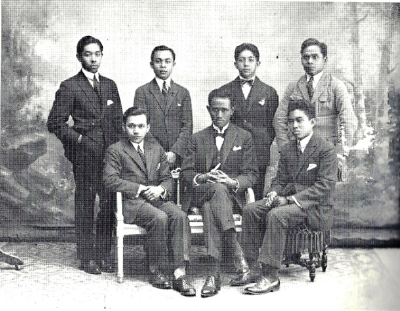
Board Indische Vereeniging 1924 (Society). Moh. Hatta (standing 2nd left), Pamontjak (sitting 1st right) (Source: H. Poeze e.a. p.178)
In 1908 the students and artists founded the Indische Vereeniging (I.V.), which was mainly dedicated to meeting, culture and mutual aid. During that period also in the same way separate organizations for Chinese students started (Chung Wha Hui, or Chinezen-Vereniging Nederland, Chinese Society Netherlands), and also for Muslims, Christians, servants and seafarers. Because of the growing political movement for independency the Indische Vereeniging radicalized and in 1922 the society was called ‘Indonesische Vereeniging’ and from 1925, in the Javanese language, ‘Perhimpunan Indonesia’ (P.I.). The battle-cry was ‘Indonesia merdeka!’ – Indonesia free! The student of economics and later on president Mohammad Hatta was one of the chairs and Sutan Sjahrir, the later on prime minister of Indonesia, was a member of the board.
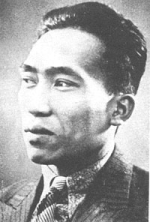
Rustam Effendi (Source: BWSA socialhistory.org) e.a. p.178)
At the end of the twenties the P.I. became part of the communist movement, also because only there they could find permanent support for a free homeland. This was also expressed by the position of the P.I. board member Rustam Effendi, who became in 1933 an M.P. for the Communist Party of the Netherlands. During that time both Hatta and Sjahrir were suspended as members.
Rupi
Many students were unhappy with this change of course. There was already a ban on members of the Perhimpunan Indonesia to become a civil servant, so many were involved in secret – therefore there are no pictures of the board. But for communists this ban was even stronger. An awkward position for those who aspired a colonial job in government later on. Thus in 1936 a new cultural and social society came about: Rupi. It's name in full meant: ‘Rukun Peladjar Indonesia’, Union of Indonesian Students. In the board were members of different islands, university cities and convictions together. Leiden was the centre, but there were also groups in The Hague, Amsterdam, Wageningen and other towns.
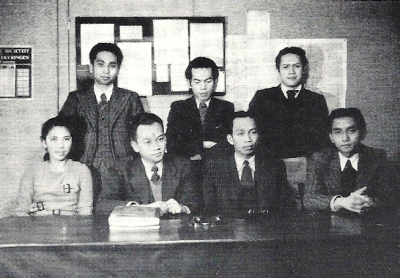
Rupi board 1940. Left to right sitting: Evy Putiray, Suripno, Daliluddin, Rozai Kusumasubrata. Standing: Rasomo Wujaningrat, Amir Hamzah, Maruto Darusman (Source: H. Poeze e.a. p.178)
Familiar names were Sunito (law), Darusman (Indology), Daliluddin (Atjeh, chemistry), Suripno (chemistry) and Evy Putiray (Moluccas, chemical analyst). The first four of them were, like many others, also member of the Perhimpunan Indonesia. From 1936-37 the P.I. mitigated its course and started to give priority to the combined battle against nazism and fascism. Aid campaigns were organized for China, which became victim of the Japanese aggression in 1937, and the organization participated in international peace meetings in Brussels, New York and Paris. The various societies were moving closer together anyway because of the threat of war. The second Cultural Conference which was organized by Rupi from 7-8 September 1940 in the Club House in Leiden, counted 119 participants, among them non-students.
Occupation
Because of the German occupation the Netherlands were cut off of its colonies as were the colonies from the Netherlands. From January 1941 Indonesia also became occupied, by Japan. Because of the wars the students had no more financial support from their families and they faced problems with rent, food and study costs. Universities, funds and authorities filled in, though usually only for basic needs. The Leiden Rupi Club House at the Hugo de Grootstraat 12, ‘Rumah Indonesia’, became a central address for support. There were meals for those who had coupons (or not), medical consulting hours, cultural shows and a society magazine.
Badan Perantaraan
At the second Cultural Conference six organizations decided to co-operate in Badan Perantaraan (Body of Mediation) platform. They were Rupi, the P.I., the Perkumpulan Islam (Islam Society), the Indonesische Christen Jongeren (I.C.J.) (Indonesian Christian Youth), the Kaum Muda Indonesia (Indonesische Jongeren, K.M.I.) (Indonesian Youth), founded for seafarers, and the Kaum Ibu Indonesia (Indonesische Moeders) (Indonesian Mothers), founded for babu's. Other groups possibly stayed out, because of the demand to recognize Indonesian nationalism.
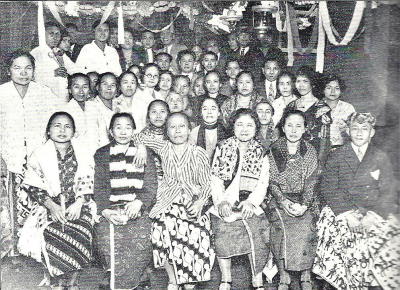
Final Fest Ramadan ('Lebaran') in the house for female and male servants, ‘babu's’ and ‘djongo’s’, Persinggahan House, The Hague (1934). Far right: minister Rana Disasmita, deceased during the war (Source: H. Poeze e.a. p.178)
Victims
Many faced hard times. From the estimated 800 Indonesians in the Netherlands at least 86 died, over 10%. Most of them due to a combination of bad and uncommon food, severe cold and illnesses as tuberculosis. During the war the Perkumpulan Islam in The Hage buried 33 persons; during the first three years of war 14, during the last two years 19 persons. About the students from Leiden: in 1940 there were 39 Indonesians. Between May 1940 and the spring of 1944 12 of them had died. 8 of them of tuberculosis, whilst 7 of them were ill of the disease. Rupi chairman and student of law Purnomohadi died in April 1943 of an attack on a train, as well as Mrs. Sadjem from The Hague, three months later. The labourer Nitie Nardjam died in March 1944 because of a bombardment on The Hague. Eight other Indonesians died because of activities for the Resistance - one of them, Bhima Jodjana, because he studied in France and became a hostage of war. The last was Rawindra Notosuroto, who died in November 1945 because of the misery and tuberculosis he sustained earlier in a German correction prison.

From the P.I. magazine Indonesia, 15-1-1946 (Source: H. Poeze e.a. p. 329)
Resistance 1940-1944
Because of its communist course the Perhimpunan Indonesia was already used to illegal activities before the war. After the magazine ‘Indonesia’ had been prohibited the illegal 'Madjallah' (Magazine) was published from the Leiden Club House, followed in 1941 by a typed nameless leaflet. The P.I. was sufficiently in the centre of attention to, already in 1941, experience raids at its members in Leiden and Amsterdam. The doctor Parlindungan Lubis and the jurist Sidartawan Kartosudirdjo were arrested. The last one became the first victim of the P.I. He died on 15 October 1942 in Dachau. Lubis survived two Dutch and two German camps.
The organization was tightened. Next to chairman Setiadjit (‘Adjit’) Sugondo three others became leading members: Sunito, Suripno and Darusman, all with Dutch aliases. P.I. members were to follow orders by the leading members. How this went on, was told by Evy Putiray in her interview by Herman Keppy (2010). There was a structure of cells with five P.I. members each. One of them was in contact with the leading members and handed down the instructions. There were weekly meetings for training or a new assignment. There were student resistance groups in Leiden, Amsterdam, The Hague, Rotterdam-Delft, Utrecht and Wageningen. From mid 1942 there were even four sub-groups in Amsterdam. Leading members were Sianturi, Rasono Wurjaningrat, Ticoalu and Daliluddin. All members of the Perhimpunan Indonesia were in the Resistance this way. This usually also applied to their partners or fiancées.
Partners
The P.I. co-operated in the Resistance with the Islamic and Christian Indonesians, as before in the Badan Perantaraan. Evy Putiray was link with the Indonesian Christian Youth. With Sianturi, her later husband, she organized five I.C.J. conferences during the war, where everybody, also people in hiding and Dutch students, was welcome. A famous place was the conference center in Kerk-Avezaath (Tiel).
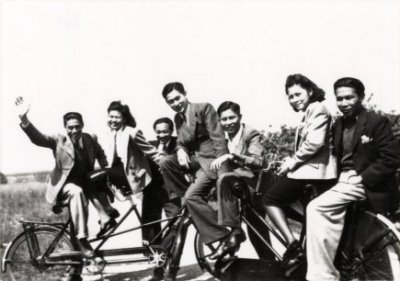
ICJ conference center Kerk-Avezaath. Left to right: Mr. Oey, Dora Maria Sigar (wife of Sumitro Djojohadikusumo), Moorianto Kusumo Utoyo, unknown, Estefanus Looho, Mrs. Olga Nelly Sigar (later wife of Estefanus Looho) and Jusuf Muda Dalam (Source: Facebook)
Evy tells in 2010 how big solidarity was, despite huge differences in religion or political views. There only was, she says, a difference with the student of economics Sumitro Djojohadikusomo, who admired Japan, ‘because we as P.I. believed Japan to be fascistic and a friend of nazi-Germany’. Still Sumitro helped the P.I. group in Rotterdam.
Dutch Resistance
The Perhimpunan Indonesia was also in contact with Dutch groups. In Amsterdam for instance with the illegal newspapers Vrij Nederland, Parool, Waarheid and De Vrije Katheder. One gave them information about the situation in Indonesia and supplied couriers. The last three papers were stencilled in the house of the family Susilo (Euterpestraat 167). And Setijadit was from the beginning editor of the student resistance magazine De Vrije Katheder.
Activities Rotterdam
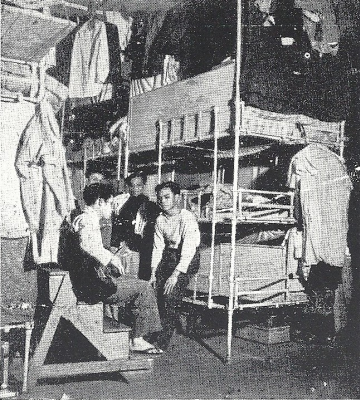
Indonesian seafares from 1946 (Javakade, Amsterdam) in a similar situation as their Lloyd colleagues between 1940-1945 (Source: H. Poeze e.a. p. 336)
The P.I. group of the Rotterdam students had a special character. The Handelshogeschool (Higher School of Trade) supplied during the entire war an allowance, which made surviving much easier. Also the harbour played an important role. Because during the days in May of 1940 66 Indonesian seafarers of the Koninklijke Rotterdamse Lloyd and the Maatschappij Nederland got grounded. They could not return. Material supplies by Lloyd were good, but the P.I. group, among them three children of doctor Pratomo from Djokja and a Dutch fiancée of one of them, were worried about a pro-German attitude and recruiting for the Arbeitseinsatz.
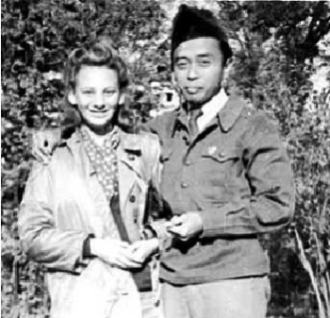
Stennie Gret and Djajeng Pratomo (ca. 1945) (Source: www.academia.edu)
The group also participated in the common Resistance, especially by the distribution of illegal pamphlets. After a while Djajeng Pratomo went living in The Hague because of safety issues. But there, after the arrest of his fiancée Stijntje Gret, he was arrested as well on 18 January 1943, together with housemate Mun Sundaru and two visiting labourers, Hamid and Kajat (see picture krontjong group Insulinde). The two students were sent to prisons and camps in the Netherlands and Germany. Mun Sundaru succombed in February 1945 in Neuengamme.
Delft and Utrecht
Two members of the P.I. in Delft were already in the common student Resistance and local illegal activities. After the protests against the discharge of three Jewish professors and two lecturers on 23 and 25 November 1940 they temporarily went into hiding. The Technical University was closed. The same, protests and closing, happened the week after in Leiden. In May 1942 Moorianto Kusumo Utoyo was sent to the Rotterdam group. Thahir Thajeb became that ill that he had to be admitted to hospital.
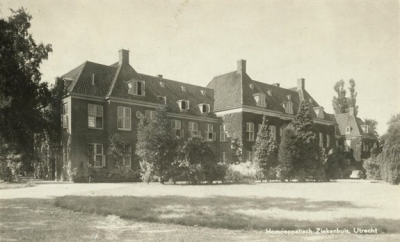
Homeopatic Hospital in Oudenrijn (ca. 1940-1948) (Source: www.hetutrechtsarchief.nl)
In Utrecht in the Homeopatic Hospital the room of a nurse, Djudju Sutanandika, became the centre of the P.I. Resistance. This hospital was located in the former Oudenrijn – nowadays the Kanaleneiland. In 1944 Djudju went to Wilhelminagasthuis (hospital) in Amsterdam where she continued her resistance work. In 1944-45 she worked as a carer and nurse with the fighter group of the P.I. in Leiden (Oegstgeest).
Leiden and Amsterdam
Also in these cities Indonesians and P.I. members participated in the common and students Resistance, for instance against the discharge of Jewish professors on 26 November 1940. Familiar names are Darusman, Hadiono Kusumo Utoyo and Suripno. The following closing of the University of Leiden was a blow. The future of the studies and the examinations became uncertain. A year later it became possible to continue studies in other towns. Most Indonesians then left for Amsterdam. Also the Club House moved there. They ended up in a building at the Willemsparkweg 194, where also a few students could live. In February, August and September 1943 several Indonesians were arrested in Amsterdam and temporarily detained, among them son and daughter Susilo. The stencil machine could be smuggled to the Club House. But because of tightened German regulations, later that year the building had to be closed.
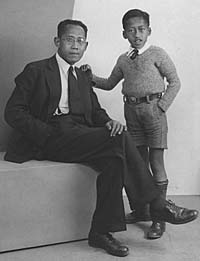
Darsono and Alam Notosudirdjo ca. 1940 (Source: www.lowensteyn.com/indonesia/kommunis.html)
Darsono
Darsono Notosudirdjo, pupil of Henk Sneevliet and in 1924 one of the founders of the Communist Party of Indonesia (PKI), went living in the Netherlands in 1933. Before that, during his stay in Moscow, he had broken with communism. Darsono did not join the P.I.. But during the war he was part of the Amsterdam Resistance, also as editor of the illegal weekly magazine ‘De Vlam’, founded by Jef Last.
The Hague
The very early resistance group of law student Rawindra Notosuroto, in The Hague and Leiden, also originated without connection to the Perhimpunan Indonesia. His father, Raden Mas Noto Suroto, was a well know poet and politician, who was at the cradle of the Indische Vereeniging in 1908. Already in July 1941 the group was completely rounded up and Rawindra survived the war only for a few months after over 2,5 years in a correction prison. He died in the Netherlands of neglected tuberculosis and weakening. His sister Dewatiah was also active in the Resistance, but had not been arrested. Their mother Jo Notosuroto-Meijer lived with the children in a part of The Hague that became 'Sperrgebiet' (forbidden area). Then she moved to Zeist. There she was caught because of her resistance activities and she ended up in camp Ravensbrück, which she survived.
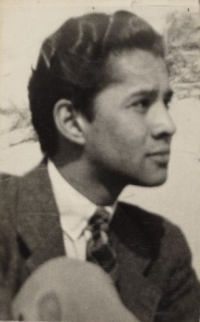
Rawindra Notosuroto (ca. 1940) (Source: www.oranjehotel.nl)
‘Facts’
Another illegal group in The Hague, lead by the P.I., started at the end of May 1943, after the compulsary handing in of all radio sets, with a stencilled newspaper: ‘Facts’. In principle the one page bulletin was published daily. It started with the curious sentence: ‘From the information of the United Nations we derive the following’. For composition and printing they co-operated with colleagues from the Government Bureau of Metal Industry, where two of the Indonesians worked. Also the students were in Indonesian labourers, who co-operated as distributers, couriers or in other ways.
Arrests
On 3 April 1944, after treason, three editorial staff members were arrested: Muwalladi, Dradjat Durmukeswara and H. van den Bosch. Dradjat was important as a contact with the seafarers (K.M.I.), but not the leader who escaped. It was, together with technical draughtsman Van den Bosch, Ulam Simatupang. The names of the three other P.I. students had remained secret. They were the jurists Tamzil and Pamontjak, in the Netherlands since 1919, and the only Chinese member of the Perhimpunan Indonesia, the jurist Si Siu Giang. In August 1944 eventually four people of the network around 'Facts’ could be sentenced: Van den Bosch, a person in hiding who helped him with stencilling, Dradjat and a colleague from the Government Bureau, Hoenderop. Durmukeswara was sentenced to three years and sent to the correction prison Siegburg, which he survived.
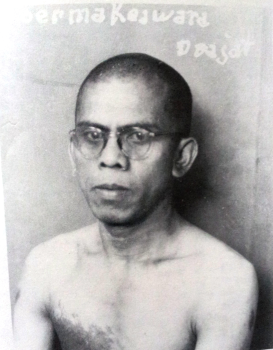
Dradjat Durmukeswara, registration Zuchthaus Siegburg 1944. (Source: Indische Letteren, jaargang 25 (2010), www.dbnl.nl)
Help to Jews and others in hiding
Here Pratomo and Keppy complement the story of Harry Poeze, who does not write about the help to Jews. Pratomo tells several units of the Perhimpunan Indonesia were intensively involved in helping Dutch Jews and Dutch people from the Resistance who were wanted by the nazis. They supplied, in Rotterdam, Delft, The Hague and Leiden, hiding places, food coupons and identity cards. Evy Putiray tells in her interview you just could be told to 'put away two Jews', which meant you had to find a hiding place for them where they were cared for’. In 1942-1943 Indonesians brought two groups of Jewish children from Amsterdam to a hiding place in the woods of the Veluwe and cared for them. Forty years on, by pure chance, one of the Indonesians met one of these children - who had become a doctor - that were taken into safety at that time. Could it have been Slamet Faiman or Rachmad Kusumobroto? Herman Keppy pays special attention to them on his website.
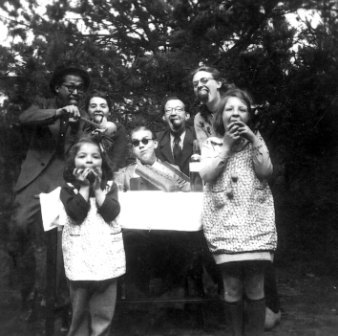
Rachmad Kusumobroto (1st left) with Nel v.d. Bergh (2nd right), Jewish children in hiding and others (1942) (Source: bd.yadvashem.org)
After the closing of the university, Leiden law student Rachmad Kusumobroto came into contact with the resistance work of his fiancée Petronella (Nel) van den Bergh. She worked in Utrecht at a shop owned by Jews, until this shop was taken over by a German ‘Verwalter’ ('trustee'). Nel helped Jewish children to go into hiding, among them the sisters Miri and Emi Freibrun. Rachmad helped her with this work. After a raid Nel was arrested and executed in February 1944 in camp Vught. The Freibrun girls survived, as well as Rachmad.
The Amsterdam P.I. member Slamet Faiman, trained as a seafarer and president of the K.M.I., also dedicated himself to Jewish and other people in hiding. Among them was the wife of fellow countryman L. Notohadinegoro-Brilleman. He looked for places for them, often with him at home in the Van Eeghenstraat 11, and forged papers. Also the Leiden student Irawan Sujono went into hiding with him. The polio he attracted during his illegal activities left him disabled for the rest of his life.
Keppy also mentions the name of Tole Madna (1898). He was not a member of the P.I.. Tole once came to the Netherlands as a foster child and lived with his babu Mina Saïna in The Hague. In 1942 Jewish Gitel Münzel came to ask for a hiding place for her nine months old son Alfred. Her husband and two older children were already under cover. The child stayed until the end of the war. Gitel survived Ravensbrück and found Alfred, as the only one of the family, alive with Tole and Mina.
The former Member of Parliament Nico Palar (SDAP) and his wife Joke Volmer can also be mentioned. Joke was already involved in spreading illegal papers and the distribution of coupons. Also their one-bedroom house in the Amsterdam Uiterwaardenstraat served a number of times as a temporary shelter for (Jewish) people in hiding.
Four military men
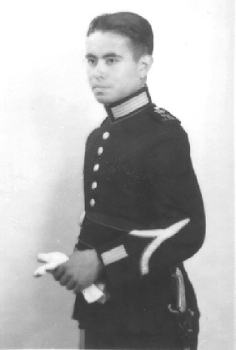
Viktor Louis Makatita (ca. 1939) (Spirce: www.hermankeppy.nl)
One of the four Indonesian cadets who started in 1939 their studies at the Royal Military Academie (KMA), Moluccan Victor Louis Makatita, was demobilised after the occupation. He was a free man and, unlike the others, not transported in 1942 as prisoner of war to Germany. In February 1942 Makatita, together with a KNIL colleague (Royal Netherlands Indies Army), tried to go to Switzerland or even the Netherlands Indies after that. Victor was arrested at the Swiss border and shot on 9 April in Dijon, together with two fellow-sufferers.
A second military person killed was also Moluccan, Eduard Alexander Latuperisa. He was a captain of the infantry of the KNIL in the Netherlands Indies and after arriving in 1939 in the Netherlands received a military staff function. After the occupation he became involved with the illegal 'Security Service' (O.D.), but was arrested in March 1942. Fifteen months later, on 29 July 1943, Latuperisa and sixteen other prisoners were shot at the Leusderheide.
The third military person who died during the war was non-commissioned officer Mas Sumitro. He lived with his wife in Soest and did not report himself during the occupation as German prisoner of war, but went into hiding. Sumitro then joined the Resistance, first in Soest, later on in The Hague. There, in the autumn of 1943, he jumped or fell out of a tram, and sustained such serious injuries that he died on 26 January 1944.
On his website Herman Keppy also mentions the Moluccan Wim Sihahainenia, who was in the battle of the Sea of Java (27 Febr. 1942). He was rescued and via Tjilitjap (Cilacap) and Colombo he ended up in Scotland, where he became a stoker aboard the O15, a Dutch submarine. There also people from Java and Menado (now Manado) served. Wim and his colleagues managed to get through the war unhurt. For sure there were more, unnamed Indonesians in the Dutch and Allied Forces.
Surviving
Apart from the support by universities and academies and the help via Rupi and similar organizations, there were different possibilities to get through the war. During the first years there still were ‘rice coupons’, but this came to an end because of poor supplies. Also the fuel allotments declined, while the winters were severe. All this resulted in students and labourers (the first mostly left wing and the last usually traditional islamic) who started living and working together. Until October 1943 the Ministry of Colonies payed Indonesians and Chinese - even though non-Aric - an allowance. Evy Putiray mentions an amount of 90 guilders a month, and speaks about it as 'bribe money'. Fiancées usually did not get married in order to keep the double allowance. At some point the allowances ended, presumably because of plans for forced labour in Germany, though the plans never fully were carried into effect. Students then had to try to get a job.
Colonial Institution
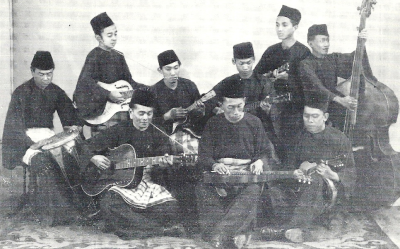
Krontjong group Insulinde (1941-1944). Front left to right: Moh. Jasin, Sugeng Notohadinegoro, Dradjat Durmakeswara. Back: Mustaman, Djajeng Pratomo, Hamid, Kayat, I.A. Mochtar, Untung Kasim (Source: Harry A. Poeze e.a., p. 313)
During the war the Colonial Institution, later known as the Royal Tropical Institute, offered financial support to Dutch colonials and Indonesian students. It also contracted Indonesian ensembles for dance, music, theatre and battle dances (pencak). They were mainly ‘Ardjoeno’ (1940) and ‘Insulinde’ (1941). Insulinde elaborated on the 'orchestra' of Indonesian seafarers (K.M.I.) and took in P.I. students as well. Also the social-democrat Palar, MP for the social-democrats (SDAP), played as a guitarist. The orchestra could perform in the Institute every fortnight on Sundays and was offered performances in other towns every month. The same applied to ‘Ardjuno’. In 1944 this ensemble was succeeded by ‘Bintang Mas’, for which the Colonial Institute contracted jurist and P.I. member Abdulmajid Djojoadhiningrat as an advisor. In August 1943, like Lillah Susilo and many others, he worked on a huge theatre production of the Institute in the Municipal Theatre, ‘De omgeslagen prauw’ ('The keeled over piragua'). The members of the Perhimpunan Indonesia poured the fees of the performances in the funds of the organization. So this was literally a ‘battle dance’. The Colonial Institute, though headquarters of the Gestapo, served as an illegal meeting place at the same time.
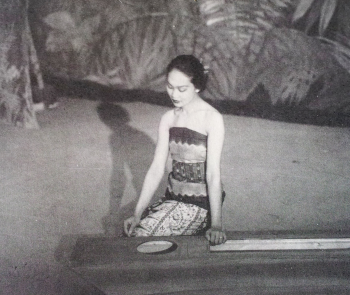
Lillah Susilo in 'De Omgeslagen Prauw' (Source: Harry A. Poeze e.a., p. 315)
East and West
This old organization for information about the Netherlands Indies and help for Dutch colonists and ‘inheemsen’ ('indigenous') (1899), became active during the war in several places for Indonesian students. Early 1942 former governor of the east coast of Sumatra, H. Ezerman (Arnhem), came to the aid of Rupi. Through him the meals in the Amsterdam Club House were funded. Former governor of Celebes, dr. L. Caron (Amsterdam), also came to the aid, with funds from the trade and industry. He distanced himself though from left wing ideas and actions against the occupier. Studying was the message.
Co-operation legally and illegally
Though of different opinions, the board members of the several committees for help to Indonesians knew each other well. The Indonesian community was small, some played and danced together with ‘Insulinde’. Members of the illegal Perhimpunan Indonesia therefore could do their resistance work without risk of treason and regularly used the social network of tolerated organizations like the Indonesian Christian Youth and the Perkumpulan Islam. This last one organized the major part of the Indonesians from The Hague.
Perkumpulan Islam The Hague
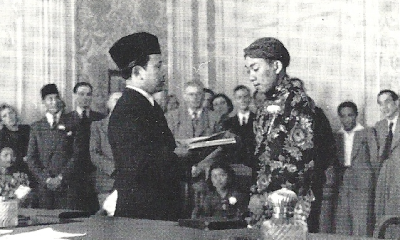
Kassanna accredits the oath at a marriage in city hall of The Hague (Source: H. Poeze e.a. p. 317)
During the years of war the centre of the Perkumpulan Islam was the house of chairman Kassanna (Obrechtstraat 220). The organization received help by students and graduates for their social and medical aid; these were persons like the doctors Abdulrachman (former Rupi), Murti Moerman and Sunarjo. Fund raising was done by jurist Zairin Zain (also former Rupi) and the economists Sumitro Djojohadikusumo and Saroso Wirodihardjo. This group of former students from Leiden and Rotterdam were in favour of independency for Indonesia, but kept themselves - contrary to the Islamic organization - out of German-Dutch affairs. In the social field they were pragmatic though. In the last year of the war Sumitro and Saroso helped the P.I. group Rotterdam to care for the seafarers at Lloyd.
Perhimpunan Islam The Hague
The P.I. group The Hague kept itself aloof from the Islamic Perkumpulan. Under the leadership of graduate jurist Suhunan Hamzah, and funded by Ezerman, they aimed for support of older Indonesian women. These usually were servants and they supplied them with butter, potatoes and clothing. The Perhimpunan was also involved in another project in The Hague: assessing requests for Indonesians and Chinese. For this the Leiden university invited jurist Kusna Puradiredja and also doctor Mohamed Ilderem, member of the P.I.. The committee Puradiredja actively encouraged these requests for support. From September 1944 it asked, supported too by East and West, the Dutch public to give Indonesian students hospitality and a meal. Which happened.
Others
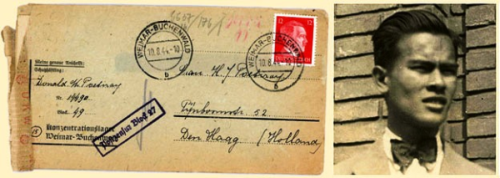
Donald Putiray, with letter from Buchenwald (10-8-1944). Source: www.hermankeppy.nl
Collaboration
Apart from the attitudes of resistance, turning a blind eye on the support of it and complete non-intervention, there sometimes was collaboration with the Germans too. The best known example is the steward from Madura mr. Tumjati who worked for the Rotterdam Lloyd. Early 1941, after discharge by Lloyd, the Colonial Institute employed him as vendor and dancer. For a short time during that year he was a member of the NSB (Dutch nazi party), who quickly stroke him off as a member, as he was a coloured person. Early 1943, together with his Dutch fiancée, he founded an art ensemble, Sinar Laoet (Ray of the Sea). After some time the ensemble counted twenty persons from Java and Madura, and they performed Gamelan, Krontjong and Hawaiian music, as well as dance. The Colonial Institute considered the quality insufficient, but Tumjati was successfull. He regularly performed until the end of 1944, also for the NSB and in Germany.
Resistance 1944-1945
The last year of the war, during which the southern part of the country was already liberated, the railway strike paralysed parts of the country and the Hunger Winter began, was also a year of increasing resistance and relentless German repression. The Perhimpunan Indonesia undertook new illegal activities and did so often together with other groups.
Part of the Illegality
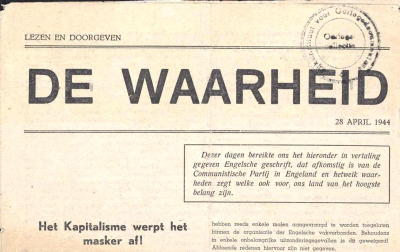
De Waarheid (the Truth) of 26 April 1944 (Source: geheugenvannederland.nl)
From the Amsterdam group Setiadjit, Suripno and Sunito talked to and wrote for illegal left wing newspapers, like the Vrije Katheder (Free Chair) and the Waarheid (Truth). They also stencilled these for three to four months. The Indonesian received typed stencils of De Waarheid on the street and printed the copy in a house in the south of Amsterdam. Then the papers were put in a suitcase and delivered at an address at the Stadionweg. The P.I. presumably was also in contact with the Resistance Board (RVV) and there were even connections with the - not very pro-Indonesian - Trouw (Faith) group. Eight students from Leiden trained with weights to be able to transport the type of Trouw without any obvious effort. The people of this ‘lead team’ were called the Amanullah’s - after a progressive emir from Afghanistan.
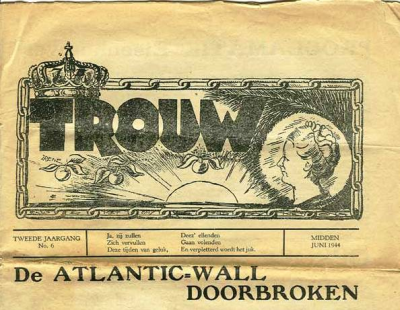
Trouw of mid June 1944 (Source: markt12.nl)
When on 4 July 1944 on desire of Queen Wilhelmina and the prime-minister the Grand Advisory Committee of Illegality (GAC) was set up, the Perhimpunan Indonesia became part of the left wing section and Setiadjit was their representative.
Female P.I. members
From the Amsterdam Wilhelmina Gasthuis (hospital) Djudju Sutanandika stayed in contact with Setiadjit. Through him she heard about a Resistance man who was sentenced to death and was in the isolation ward, where she happened to work. After his recovery from scarlet fever she managed to help him escape. The man probably was a member of the Resistance Board (RVV). Other women worked mainly as couriers because as men were sooner arrested because of the hunt for those who tried to escape the Arbeitseinsatz (forced labour). Familiar names are here: the jurist Tuti Sudjanadiwirja, Sutiasmi (Mimi) Sujono, the analyst Evy Putiray and student of law Trees Heyligers, fiancée of Sunito.
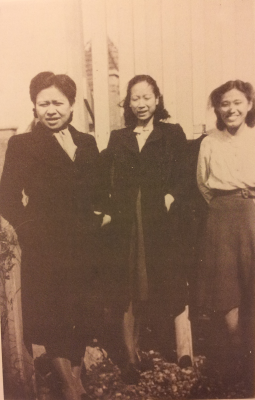
Tuti Sudjanadiwirja, Sutiasmi Sujono, Evy Putiray (Source: Harry Poeze e.a. p. 321)
Evy tells in the interview with Herman Keppy how she delivered illegal newspapers by train. When she travelled from The Hague to Haarlem and had to deliver something at a certain place, she went to the station early and searched for an empty carriage. There she put the package in an empty luggage net and then went to another part of the train herself. In Haarlem she waited until the train was almost empty, recovered the package and put it in her hand-bag. As ‘naive black girl’ she could pass the inspection. Which she did indeed.
Dutch P.I. member
In 1943 at the Colonial Institute Abdulmajid Djojoadhiningrat learned to know biology student Frits Bianchi. He happened to be a fierce proponent of Indonesian independency, also in discussions with acquaintances of Abdulmajid. To his surprise Frits was offered the P.I. membership by Sunito. He accepted the offer and also the corresponding discipline. This way Bianchi had a part in the Amsterdam Resistance work, from stencilling to training with weapons. Probably Trees Heyligers can also be considered as a member. After the war she defended 'Netherlands Indies-refusers' (Dutch military who refused to serve in the war against the Indonesians who fought for independence), like the well known Piet van Staveren and Zaandam citizen Arie Buth (1927-2010).
Liberation
Also in Leiden the P.I. worked closely together with Dutch Resistance groups and illegal newspapers. Because of that they were, despite arrests in April 1944 around the paper ‘Facts’ (The Hague), able to publish a new paper in June, this time in Leiden. It had the provocative name ‘De Bevrijding’ (The Liberation) and contained mostly news messages. Nothing pointed to the Perhimpunan Indonesia being responsible for the publications, but veteran Pamontjak was the main editor. He was assisted by the editors Suripno and Harahap (vicar), and by Ticoalu, Irawan Sujono, I.A. Mochtar and Rozai Kusumasubrata, who organized the press and distribution. With help from the Leiden illegality the paper was stencilled. It was published three times a week in editions of 3,500, increasing to 20,000 towards the end of the war. This was enormous. Irawan, also named ‘Henk from The Liberation’, did the technical work: machines, paper, radio sets. During a raid on 13 January 1945 he fled by bike, but was lethally hit by a nazi bullet.
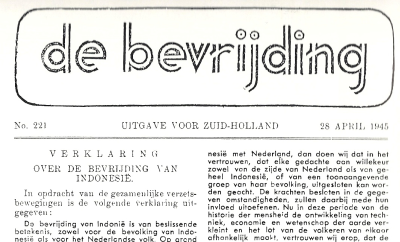
Illegal newspaper De Bevrijding, ed. 28 April 1945, about the liberation of Indonesia (Source: H. Poeze e.a. p. 326)
From September 1944 the newspaper also appeared in The Hague. Because of the railway strike it had become impossible for couriers to get the paper to other towns. The members of the 'Facts' group who were not arrested already were, together with Daliluddin, responsible for the editions. Sometimes the The Hague editors took over, by courier, editorials from the Leiden edition. They picked from the war messages themselves and sometimes wrote about Indonesia. The ‘Bevrijding’, made in The Hague, had only one page, was published three times a week to daily and had an edition of 4,000.
Also Rotterdam had its own edition. Again there was help from other Resistance groups for edition and distribution, but the editors were the economists Jusuf Mudadalam and Gondo Pratomo, brother of Djajeng Pratomo who had been arrested in 1943. The editors managed, with help from a Jewish man (in hiding) to make in a house in the Burgemeester Meineszlaan a radio listening post, by means of which the editors could have the latest information of the Allies. Gondo also managed to rent a house at the Aelbrechtskade, where a stencil machine was installed. With it the ‘De Bevrijding’ and later on the Rotterdam edition of the ‘Vrije Katheder’ could be printed, and also temporarily ‘De Waarheid’. Also here the main leaders of the P.I. could be welcomed. Sunito and Darusman came for discussions. Setiadjit went into hiding for a couple of months in the house.
Armed Resistance
In 2014 Djajeng Pratomo tells the following about the start of the Armed Resistance. The Rotterdam student of economics Jusuf Mudadalam was in a Dutch K.P. group, also known as knokploeg (strong-arm boys). In 1944 they made a successfull attack on a police post, where they managed to obtain four Walther pistols. Later the Indonesians in Rotterdam received more weapons via the Dutch Resistance, like two carbines, five pistols and ammunition. They came from German Wehrmacht soldiers who were in hiding with Dutch families, and who were fed up with the war. The Indonesians were trained by one of them, a ‘Gefreiter’ (lance corporal), trained how to use these weapons. Mudadalam also participated in an attack on a distribution office for food coupons in The Hague. The attack was done by bike and the action was a success. But at the meeting point the members were ambushed by the Germans. Jusuf managed to escape, with his machine gun and other weapons. Later on the Rotterdam P.I. group could retrieve with a carrier cycle nine jute bags with hand grenades, disassembled stenguns and ammunition at a Dutch Resistance man in the Watergeusstraat. The weapons came from droppings by the R.A.F.. So the P.I. was well supplied.
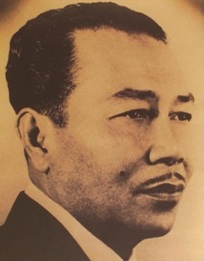
Jusuf Muda Dalam, minister and bank governor under Sukarno (1964) (Source: pekerjamuseum.blogspot.com)
Domestic Armed Forces (B.S.)
This umbrella organization of the armed resistance movement had a student branch in Leiden. This branch had been founded by Suripno and had four groups. One of them was made up by the Perhimpunan Indonesia. The group was named after the Indonesian hero Surapati and was lead by Ticoalu or ‘Theo’. The P.I. strongly valued to be part of the Dutch battle for freedom and provided ten members. At an armed liberation of the city their task would be to take and hold the Leiden railway station. Because of the German surrender it did not get that far.
The members partly came from other towns: Moorianto Kusumo Utuyo from Rotterdam, Rozai Kusumasubrata and Djalal Muchsin from Amsterdam. The P.I. often had experience with espionage and sabotage in the Knokploegen. Djajeng Pratomo tells how they managed to get the stock of weapons collected by the Rotterdam group with Mudadalam, past the German inspection posts, by bike, along stealthy roads to Leiden. The Indonesians trained in Leiden in one of the cellars of a wool and sheet factory. After the death of Irawan Sujono the group called itself ‘Irawan’, and like this they marched in the Liberation Parade.
Evy Putiray tells Herman Keppy she was sent by the movement to Oegstgeest (Leiden) shortly after the death of Sujono. There eight P.I. students were in hiding. Vicar Frits Harahap was one of them. They were in the Resistance and had the task to attack distribution offices and steal food coupons. So they were presumably members of the B.S. group. Evy was not a member - her fiancé, Sianturi, was in Amsterdam busy with weapon training though - and neither was nurse Djudju (‘Juju’) Sutanandika, who cared for food and nursing of the students. In Leiden Evy worked as a courier. After 9 p.m., at 'Sperrzeit' (curfew), she went outside with parcels full of copy from the illegal papers. Vrij Nederland, De Waarheid and Trouw. She had to deliver the copy at a secret printer. Irawan Sujono had just been shot with this kind of work.
Hunger Winter
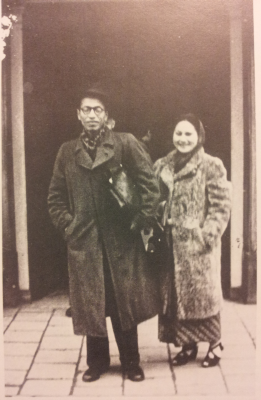
Setiadjit and Elly Setiadjit-Sumokil (ca. 1943) (Source: H. Poeze e.a. p. 306)
Evy Putiray tells more about Oegstgeest. It was the heart of winter and everybody was hungry. Her trip had been together with five other students, on bikes without tires. The three boys peddled, the girls sat at the back. Elly Sumokil, Setjiadit's wife, had a child three months old, who she had brought to a niece in the het Wilhelmina Gasthuis. She insisted on coming with them to Leiden. Once they were there she went straight into the kitchen to express milk. Juju immediately said: ‘'don't throw it away!’ Because it was the only milk in Oegstgeest. And so the boys had twice a day a ‘kopie susu’, coffee with milk. Exchanged with ‘tukang susu’ (milk man) for sheets, said Juju. Until Elly was gone after a week. ‘Where has the milk gone’, asked the Resistance men. ‘Our cow is back in Amsterdam’, Juju said. They were startled, but Juju and Evy laughed.
Leiden
The leadership of the P.I. really valued being present in the Leiden area, which had declined because of the closing of the university. The B.S. group as well as the publication of ‘De Bevrijding’ fitted this vision. For both activities headquarters were in the house of main editor Pamontjak. There was a stencil machine, one listened to English broadcasts and people were assembled to receive military training in the cellar of a neighbouring wool factory. A second central place, also for other Resistance groups, was the house of Hadiono Kusumo Utoyo, brother of the B.S. member. He was engaged in hiding places, food distribution, forgery and aiding several illegal papers. In the attic he had a stencil machine. All traces of printing activities were meticulously removed every time; used 'masters' were burned. As a recognition for his role in the Resistance Hadiono was made a member of the temporary city council in May 1945.
Amsterdam
Amsterdam also knew a, smaller, Indonesian B.S. group, under the leadership of Sunito. Here they practiced, according to witness Pratomo, in a house at the Amstelkade where the fiancée of one of the students lived; presumably Trees Heyligers. In contrast to the Leiden group they had to abandon the actions just before the Liberation because they did not have enough manpower.
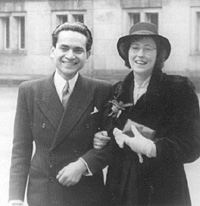
Sunito Djojowirono and Trees Heyligers on 15 Febr. 1945, their wedding day (Source: De Antifascist, Aug. 2008, www.afvn.nl)
Hunger trips
In Leiden the efforts of the Indonesian students and labourers from The Hague were coordinated to get food in the Hunger Winter. They went up as far as Den Helder (100 km) and were reasonably successfull. The Dutch were moved to compassion for the people from the warm Indies with their thin stature. Thus there was a boat drawn by hand to Leiden with a mere 7,500 kilo's of carrots. The canal was next to the railway, which was under fire by the Allies. Fortunately nobody was hurt and all carrots got to Leiden and, the other half, to The Hague.
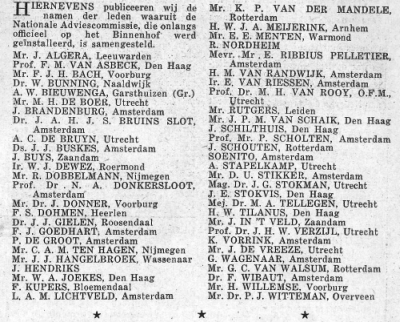
Soenito in the list of names of the Nationale Adviescommissie
(Source: Vrij Nederland 4-8-1945)
After the liberation
During the huge Liberation Parade of 8 May 1945 in Amsterdam also representatives of the Indonesian student organizations were present, while the P.I. was represented on the tribune by Setiadjit Sugondo, member of the Grand Advisory Committee of Illegality. Sunito Djojowirono became a member of the National Advisory Committee of the Former Resistance, which was in charge of filling in the free chairs in the Houses of Parliament. After 5 May the Leiden ‘Bevrijding’ revealed the newspaper had been published under the responsibility of Perhimpunan Indonesia. The paper published one extra edition ‘Welcome to our Allies’, with a summary of 5 fallen and 68 deceased Indonesians, and finally a manifest about how to achieve the independency of Indonesia.
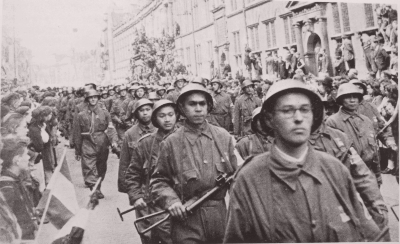
Liberation Parade, Breestraat Leiden, with the Irawan group. The last to in the left row are Moorianto Kusumo Utoyo and Ticoalu (Source: H. Poeze e.a. p. 323)
Independency
This turned out to be achieved much harder and bloodier than was expected after the cooperation against nazi-Germany. It already had appeared so after the sudden death of Ario Adipati Sujono, father of Irawan, and minister in the war cabinet: his plead for independency met with no response; he died on 5 January 1943 in Londen of a heart attack. Several former Resistance members played an important role in the negotiations with the Netherlands - both parties often knew each other personally. After May 1945 there were also four Indonesians Member of Parliament, two pre-war: Effendi and Palar, and two new: Setiadjit and Pamontjak (First Chamber). Some of the Resistance fighters were executed in 1948 as unwelcome communists by the Republic, among them Setiadjit. Others were to have important posts in the Indonesian government after 1949.
Djajeng Pratomo cites at the end of his article about the Resistance Prof. Mr. R.P. Cleveringa, who initiated the heavy protests in Leiden in November 1941 after the dismissal of Jewish colleagues. At a remembrance assembly of 37 years Indonesian National Movement he said: ‘Where there was talk in the Netherlands about resistance, we did not have to ask: Where are the Indonesians. They were there and stood sentry. They made their sacrifices. They were in concentration camps, they were in prisons, they were everywhere...’(City Theatre Leiden, 25 May 1945).
Sources
- Harry A. Poeze, with contributions by Cees van Dijk and Inge van der Meulen, In het land van de overheerser, deel I, Indonesiërs in Nederland (1600-1950). (Koninklijk Instituut voor Taal-, Land- en Volkenkunde, KITLV, Dordrecht 1986), 398 p.
- Raden Mas Djajeng Djajang Pratomo, In dienst van de vrijheid. Uit: De rechten van het verzet, 1986, zie: http://javapost.nl/tag/djajeng-pratomo (15 feb. 2014)
- Herman Keppy, Nederlands-Indië tegen Duits-Nederland, op www.Hermankeppy.nl
- Herman Keppy, Interview with Evy Poetiray 14-2-2010, zie http://getuigenverhalen.nl
- Anonymous. ‘Eerst Nederland bevrijden, dan Indonesië’. Indonesische verzetsstrijders actief in Nederland tijdens Tweede Wereldoorlog. De Anti Fascist augustus 2008, p. 21-22, op www.afvn.nl
- Herman Burgers, De Garoeda en de Ooievaar. Van kolonie tot nationale staat. KITLV, Leiden 2011, p. 441
- Alam Darsono, Het zwijgen van de vader (Stichting Alam Darsono 2008). www.alamdarsono.nl/eigen%20activiteiten/homeeigen.html
- Jeroen van Driel, e-mail 13-12-2015; http://resources.huygens.knaw.nl/bwn1880-2000/lemmata/bwn5/palar; https://socialhistory.org/bwsa/biografie/palar
Netherlands Indies during Japanese occupation

Map: stuwww.uvt.nl
The capitulation of Japan on 15 August 1945 makes an end to what is called the Second World War. This capitulation was officially commemorated in Holland only in 1970, and only once. Up til then the attention had mostly been aimed at the events in the home country. Only an urn with soil from Indonesia was added in 1950 to the other urns in the monument at the Dam. From 1980 the 15-August commemoration has been held every year and since 1988 there is monument for the Dutch victims of the world war in Asia, the Indies monument in The Hague. The money for it was raised by the victims themselves. Also in other places, like Arnhem-Bronbeek, Roermond, Amstelveen and Den Helder monuments were erected or commemorations held. Finally in 1999 the date of 15 August was recognised as a historical day: the end of the Second World War. The last erected monument (Bronbeek, 17 August 2004) commemorates the thousands of victims from the Japanese prisoner transports at sea.
Occupation
The Japanese capitulation also made an end to the Japanese occupation of the former Netherlands Indies. After the attack of Japan on the American Navy Basis Pearl Harbor (Hawai) and the American declaration of war (8 December 1941) afterwards, the Japanese warfare extended from China to the Asian areas of British, Americans, Dutch and their allies. Parts of the Indonesian islands were already attacked in January and February 1942. On 27 February the battle of the Java Sea took place: under leadership of the Dutch admiral Karel Doorman the allied fought a desperate battle against the much better equipped and prepared Japanese (see also Surinam, KNIL). On 1 March 1942 the conquest of Java started, on 8 March the colonial authorities capitulated.
The occupation of the Netherlands Indies (by some 300,000 Japanese and Korean military men and civil servants) was welcomed by a part of the native population. The nationalistic part of the elite cooperated with Japan: it would bring independence from the Dutch yoke. Indeed the foundation for an independant country and army (‘Peta’) was layed. Others mistrusted the motives and methods of the Japanese occupation and were less enthousiastic. Especially Moluccans, Manadonese (Sulawesi) and Timorese actively resisted (see story Litamahaputty).

A talisman given by family, friends and acquaintances to a Japanese soldier. It is full of the names, with our without wishes and encouragements, from these people. The large text on the right hand side of the flag says: "In honour of Mr. Tirasaki Hiroharu" and next to it "Keep courage". Wished to him by Narita Kinjuro, who probably was the initiator. It is very likely Tirasaki Hiroharu has been a camp guard because the flag was taken by an ex-prisoner to Holland - www.museumverbindingsdienst.nl/leven3.html
Oppression
The major part of the 70 million inhabitants, ‘the people’, ‘rakyat’, was illiterate, and suffered increasingly under the occupation. Almost all men were put to work, usually a ‘force labourer’, ‘romusha’, or as aid soldier, ‘heiho’. Hundreds of thousands were deported to other parts of the archipel, to New Guinea, Birma, Siam, the Philippines or Japan. Many women were forced to become prostitutes, ‘consolation girls’ (‘yugun ianfu’) for the Japanese soldiers. Farmers were forced to deliver rice. The military police, ‘kempetai’, led a reign of terror in some places. The economic situation worsened. From 1945 there was a acute shortage of food and textiles.
Indonesian consolation girls
During the Japanese occupation of the Netherlands Indies about 20,000 Indonesian, Indo-European and also Dutch women were forced to act as prostitutes ('Consolation girls') for the Japanese soldiers. After the war their stories had to be kept secret for too long. Out of shame, out of the sexual charge. Or, in the case of Indonesian women, out of respect, because Japan helped the country to free itself and the independence fighters did not want to face the Japanese atrocities. Photographer Jan Banning (made ‘Sporen van oorlog: overlevenden van de Birma- en de Pakanbaroe-spoorweg’ ['Traces from the war: survivors of the Birma and the Pakanbaroe Railway']) and journalist Hilde Janssen therefore started in 2008 the project ‘Troostmeisjes in Indonesië’ ('Consolation girls in Indonesia'), a series of portraits, in pictures and in text, of the former forced prostitutes. In Indonesia twenty women are being interviewed extensively (oral history) and photographed. The portraits are recorded in a book and a traveling exposition (source: www.v-fonds.nl/pagina_202.html).

Wainem (picture: Jan Banning, text: Hilde Janssen)
Wainem, 1925, Mojogedang - Middle-Java, was taken from her home and forced to prostitution, first a year in Solo and afterwards in Yogyakarta. Together with other women in a hangar she was forced to weave mats and cook food during daytime. Sometimes they were raped on site, but usually soldiers took them to their room at the barracks. "Every week an Indonesian surgeon examinated us for pregnancy, while a Japanese soldier was watching. I never got pregnant during that time." After the war, together with a group of women, she walked about a hundred kilometers home. "Our people chased the Japanese out with bamboo spears. They grabbed everything we had: our rice, our money, our gold. In the evening when the air-raid alarm went off and we hid ourselves, the Japanese went into our houses and ransacked the place." She would rather not be reminded of what happened in that hangar. "That is such a long time ago. My son, who wasn't born yet, already has grandchildren." (source: http://nos.nl/artikel/152957-niet-mijn-bedoeling-deze-troostmeisjes-als-zielepoten-te-fotograferen.html).
Internment
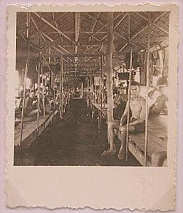
The majority of the 300,000 Dutch and other Europeans in the colony, whites (‘totoks’) and coloured (‘Indo’s’), saw the Japanese occupation comparable to what the Germans had done in Holland. Some saw though that the colonial era was nearing its end or sympathised with the Indonesian strive for independence.
Like the Germans in Surinam and the Netherlands Antilles – often anti-nazi’s and jewish refugees – were imprisoned from May 1940 in internment camps (see there), and like Japanese civilians in the United States from 9 December 1941 were interned, this also happened to a part of the highly educated European top in the western colonies of Asia. Their fate was much worse though. About 16,800 of the 100,000 interned didn't live to see the end of the Japanese occupation, which is about a sixth of the camps population (see also article Liesker and Slors).
Compared tot the occupied British and French colonies the largest number of civilians were interned in the Netherlands Indies: about 100,000. 35,000 of them were younger than seventeen years. There were separate camps for women, where also the younger children stayed; and there were also boy camps.
Sub-camps for religious
Less known perhaps is that there were also sub-camps for religious, as for instance the camp Blitar on East-Java and in camp Kuching in the Maleisian part (Serawak) of Borneo. In this camp the religious on west-Borneo were interned. How did the war start in this region?
The Friars van Huijbergen
West-Borneo in 1941
In December 1941 the western district of Borneo has a new resident: A.S.L. Spoor. He mostly has to deal with two difficulties. First: the ongoing conflicts with the military and the civil servants.

The first friars leave for the Netherlands Indies on the ss Patria (1921). In front mgr. Bos is sitting, with next to him five Sisters of Veghel. Behind them are standing (with hat and under the small arrows) friars Leo Geers, Maternus Brouwers, Canisius van de Ven, Longinus van Spreeuwel and Serafinus van Tilborg
(Source: Huijbergen en de uiteinden der aarde)
Secondly there is a conflict with the mission which from the end of the 19th century on and under difficult circumstances, achieved a lot in medical and educational affairs. From 1919 this is done on instigation of pope Benedict XV, who writes that the missions can no longer restrict themselves to Christianization but have to consist, apart from a native church, also of schools and a small hospital. Many civil servants though see this as a state within a state and try to break its power.
War unlikely
At his inauguration Spoor is told by the local military commander Ter Poorten, that they are in a quiet district and that it is very unlikely that Pontianak (Kalimantan) will become part of the war zone. They feel safe with about 50 brigades, most of them being stationed at the 'secret airfield' of Singkawag II in the north (near the border with British Borneo). There large supplies of bombs, petrol for aircraft and food are stored.
The attack from the Japanese on Java starts on 1 March 1942. Other islands, like Borneo, are attacked much earlier, in some regions just after the bombing of 8 December 1941 on Pearl Harbour.
Pontianak bombed
The first air-raid alarm is on 11 December 1941; something inconceivable at the time. On 19 December bishop Van Valenberg says goodbye to the respresentatives of the mission, who he had assembled because of the outbreak of war. They return to their missions.
From the diary, written in stenography, of friar Bernulfus Bosman from Broeders van Huijbergen (Friars of Huijbergen):
“19 December 1941. The war starts here (Pontianak) devastating. While walking on the gallery of the school, we hear planes. There's no air-raid alarm. A bombardment on the Chinese quarters follows. The Dutch-Chinese school receives a direct-hit: the schoolrooms of the youngest are in ruins (the children were already sent home) and among the older students there are 15 dead. In town there are hundreds of victims and big fires. All friars work day and night to offer help. Pontianak becomes a dead town."
Dr. A. Heilbrunn, a German-jewish doctor and head of the mission hospital, estimates about 150 dead, 180 injured in hospital, minor injuries 50 to 75, died in hospital about 50.
Friar Emmanuel Compiet who works as a teacher in Singkawang writes that the news spread like wildfire and that almost all parents have taken their boys out of the boarding school. Save for about ten boys the school is empty now. The friar travels to Pontianak to assess the situation and is met by totally exhausted fellow-friars.
Kuching and Pemangkat
On 23 and 24 December the Japanese land near Kuching in Serawak and the threat is soon closing in. Also on 23 December the airfield is bombed. And on 25 December Kuching is taken by the Japanese.
During the night from 26 to 27 January news arrives that Japanese ships are spotted along the coast of Pemangkast. Destruction groups are installed to make sure nothing usable will fall into the hand of the Japanese. Von Uslar (see also the Sisters van Etten) is commander of the destruction group. The supplies of rice are distributed among the civilians and Von Uslar starts with the destruction of the rubber factories, cars, the stock of bear and petrol. This probably is the real reason why he will be executed by the Japanese later on.
All Europeans, among them friar Juvenalis of the mission in Sambas, and Von Uslar, are arrested.
Pontianak
In Singkawang friar Compiet writes that the assistent-resident proposes to meet the Japanese as a Red Cross team and being treated as such a group, in order to obtain better treatment. The group comprises of nuns, friars, some civilians and two civil servants with Red Cross-bands. They are arrested, but the nuns and a friar are sent back to their mission posts. Later on prisoners from Pemangkat and Sambas are added to the group.
"On 27 January 1943 the Japanese occupy Singkawang (about 100 km north of Pontianak). Two days later it's Pontianak turn. The friars get house arrest and barbed wire straight next to the house. We can't even get into the garden. All the time about four men are on guard. The friars house in Pontianak becomes more and more crowded, because all arrested inland civil servants are brought here. After a couple of months there are over 100 occupants in a friars house that used to be too small to accomodate 15 men.”
Kuching (at that time British Borneo, Serawak)

Camp Kuching (Source: Huijbergen en de uiteinden der aarde)
In July 1942 the friars from Singkawang and Pontianak (Kalimantan) are housed in a internment camp near Kuching (about 200 km north-east of Singkawang). The camp has almost 3,000 inhabitants, half of them die during the following years. The camp is devided into 10 sections, one of them a section of about 100 religious (also missionaries). The sisters and nuns are, not seperately, housed in the womens section. The camp inhabitants have to work hard: they have to enlarge the airfield and build roads, during which there's more and more shortage of food. Especially in 1945 many of the prisoners die of exhaustion, dysentery and hunger oedema.


Above: Drawing of Camp Kuching by friar Cornelis. On the drawing is written: "23 Huijberg friars. Connection between two barracks. Here we stood in line with 106 religious to have our plate filled".
Below: Camp Kuching with waving men just before their liberation.
(Source: Huijbergen en de uiteinden der aarde)
On 25 March 1945 a first sign of hope: during Mass high up in the air two shining American bombers fly over the camp. Everyone runs for the trenches but the bombers drop pamphlets. But camp life in Kuching still continues for almost half a year. On 11 September 1945 the survivors are liberated. Next the survivors can recover for some months on the island of Labuan at the coast of Brunei. The friars camp on the beach, 10 meters from the sea. The ones who suffered most, are in a field hospital to regain strength.
Already in December 1945 the School of Economics in Pontianak reopens (thanks to the help of many ex-students) and in January primary school starts again.
The story of friar Angelus van der Zanden about his experiences during the war in the prison in Kediri, the men's camp Tjimahi and the camp Blitar (Java) is elsewhere on this website.
1 dead, 1 badly injured
Eventually in 1946 friar Claudius Sommen still dies of dysentery because of the hardships in the camp. Friar Ireneus van de Avoird had a hard time during the rest of his life as resulte of the inhuman treatments he was given because he always stood out for his fellow-friars in the camp.
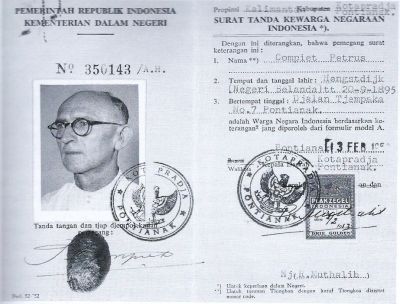
Indonesian passport of friar Petrus (Emmanuel) Compiet, 1951
(Source: Huijbergen en de uiteinden der aarde)
After 15 August 1945
After the liberation from the Japanese occupation the colonial Netherlands Indies heads for its downfall. The battle for independence is mainly fought on Java. The Broeders van Huijbergen on southern Borneo hardly notice anything. After the transfer of sovereignty in 1949 new rules apply. The official language becomes Bahasa Indonesia and other school books arrive. Finally the friars have to choose in December 1951 whether they want to have the Indonesian nationality. The ones who want to stay Dutch citizens, won't formally be able to teach after 1960. The bishop of Pontianak, mgr. Van Valenberg, advises all religious to ‘adapt to the people’, but gives everyone freedom of choice. Eventually half of the Broeders van Huijbergen accept Indonesian citizenship.
Note: The congregation of the Broeders van Huijbergen
The congregation of the ‘De Broeders van Huijbergen’ was founded in 1854 in the Brabant village of Huijbergen (Netherlands). From 1888 the emphasis was on ‘good education’ and within a few years friar primary and secondary schools appeared. Already in 1892 a private teacher college was founded.
In 1921 the first friars left for the Netherlands-Indies, the emphasis of the mission again with education. In Indonesia there are still friars of the congregation (2017).
Sources
War diary Borneo - Zusters van Etten (Sisters of Etten)

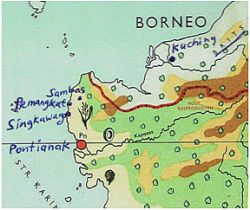
‘Borneo’, calender 2016, Bakker & Rusch, old school maps (‘Onze Aarde’ ca. 1950)
When the Broeders van Huijbergen from Pontianak arrive in Camp Kuching - also named Batu Lintang - on 16 July 1942, the Zusters van Etten have been there for three days. They are from the Sint Franciscus Convent in Sambas, not far from the border with British Borneo, and they have already been through a lot. This we know from their diary. It is an anonymus writing, as common in convents, but from the text two main authors can be derived: Sister Elisabeth and Mother Sophie. The writing itself, the temporary stop and the taking over by others, is a story in itself.

Picture of the community in 1939, during the visit of Mother Chantal from the mother convent in Etten. Some sisters from 1942 are not in the picture. Picture: Diary after p.16
Diary
On 3 July 1942 Sister Elisabeth (72) was told by Mother Sophie (63) to burn her notes, which she started in December. When discovered they would have been a threat to their safety. Ten days later, in Camp Kuching, the Mother regrets her decision and the Sister can start writing again “with courage and the help of my Guardian Angel”. She starts on 8 December 1941, and it seems very likely she recovered her former notes to do so. From the details she uses to describe the events during the former months, it is clear she did not burn the diary.
Marcus von Uslar
The danger of writing, referred to by Mother Sophie, is not an empty threat. The diary extensively presents the reason on 27 and 28 January, 17 June and on 2 July, the day prior to the order to burn it. Marcus Ernst von Uslar (Bern, 14-6-1903) is a Dutchman of Swiss descent and with whom the Sisters have a good contact. At the end of January 1942, together with inspector Bum, the priest and friar of Sambas and Father Kwadekker who is ill, he is run in by the occupiers and taken to the coastal town of Pemangkat. After a couple of days the last four are back, free. Meanwhile there has been a blaze in the center of Sambas, the ‘pasar’ (market), leaving thousands of people homeless. Five months later, on 17 June, Von Uslar is arrested again and thrown in jail. The Sisters and priest are already there for a month and witness his arrival. His mother, a Swiss citizen and subject of a neutral state, follows three days later, after a violent house search. Mother and son are not allowed to speak to each other in prison. During their stay and without their knowing (but the Sisters do hear so) their furnishing are flogged by the Japanese and more is to follow.

Part of the pasar (‘market’) of Sambas (ca 1928) Coll. wereldculturen RV-10771-36
Last hours
On 2 July, 20 armed soldiers arrive at the prison. They take a piece of rope from the Sisters, tie Marcus von Uslar up and pull him at the rope around his waist to the middle of the street. He is bareheaded and on bare feet and only wears his prison clothes: shorts. In front of him a piece of wood on a stick is carried, which says: 'This bad German burnt the pasar’. For three hours Von Uslar is dragged from kampong to kampong (neighbourhood) and across the market, and from there past the prison to the cemetery. He is not allowed to speak to his terrified mother. At the edge of a freshly digged grave he is shot. Fortunately Mrs Von Uslar does not hear the shots. She thinks her son is taken away to the harbour town of Singkawang.
But the Sisters do hear the shots and understand what happened from fellow-prisoners who had to close the grave. They can only think now that it is their turn. Secretly they go to confession with the priest, renew their monestic vows and listen to Mother Sophie who is reciting the prayer for the dying. But yet nothing happens. “ ...Our hour hadn't come yet.” Shortly after the Sisters are taken from their cells. On 13 July they are transported by boat to Malaysian Kuching, where a camp for Europeans has been opened.
Writing in Kuching
There Sister Elisabeth can take up the pen again, now the acute danger is over. In the pious and precise language of her generation Anna Catharina Swagemakers (Nieuw-Vossemeer, 14-6-1870) – thus were her secular personalia - describes the events in Sambas and the camp. Help from Above is also welcome without the incidents outside, because on 30 March 1941 she had a small heart attack at the monastery. The priest administered the last sacraments and it helped. Two years later, February 1943 in Kuching, the ilness makes it impossible for her to write. But the entries in the diary do not stop. Mother Sophie takes over writing until the end of August, when it becomes too dangerous again. After a pause until mid November another Sister, with big interruptions, continues the writing in the diary. Possibly it is Sister Floriberta who already before wrote a diary of her own. On 22 May 1945 her predecessor Sister Elisabeth dies. The diary of the Sisters ends on 22 July 1946 with parcels arrived in Sambas from many convents in The Netherlands. “Now we feel all one again.”
Book
The notes survive the occupation, emprisonment, camp, liberation and return to Sambas. Also the community in Pemangkat, possibly by Mother Eucharia, had written a short account of the events. It covers the first half year under Japanese occupation. Both documents are used to compile a little book with 144 densily printed pages: ‘De Zusters van Etten in gevangenschap en in het Concentratiekamp der Japanners op Borneo’. ('The Sisters of Etten in emprisonment and in the concentration camp of the Japanese on Borneo') Ninety pages are written by Sister Elisabeth. Below are eleven events whose description is based on the book.
1. The monastery expropriated

School, hospital and monastery Sambas. Picture: Diary, next to p. 33
Occupation
In Sambas, the capital of the Regency of the same name, the Sisters have their monastery, the 'Sister House'. From there they lead a school and a hospital. Both are being expropriated after the arrival of the 'Japs', on 27 January 1942. European men, also clergymen, are arrested, women and girls are threatened. Most Malaysians choose the Japanese side - though the sultan, Muhammad Ibrahim Shafiuddin II, workes against them - and some start looting.
Fortunately there is a Catholic among the Japanese officers. He makes Japanese inscriptions saying ‘no entry’ which the Sisters can stick to their temporary shelter in the woods. Early March 1942 all Sisters can return to their monastery, knowing none of their possessions will still be theirs. On behalf of the occupier the sultan declared that it all belongs to the Japanese army. Also the Sisters are not allowed to have any contact with the population, write letters of leave Sambas. Any violation will be answered with “being shot or head off” (p.16).

Father and workers in the rubber plantation Mission Sambas (ca. 1928). Picture: collectie.wereldculturen 10771-72
Japanese friends
After the nurses among the Sisters successfully treated a few sick 'Jap' soldiers in the hospital, and also the commander - called 'Whiskers' and 'Nicodemus’ by them - the attitude towards the nuns somewhat improves. And there is another Catholic among the Japanese, the guard Johannes. “16 March: ... Every day he walks over the concrete street to have a chance to greet Mother (Prior). One could see that they felt sorry for our tense lives". The feast-day of St. Joseph, patron of the mother house ‘Withof’ in Etten, is commemorated three days later with more confidence. (...) How would it be in occupied Holland. Would they be able in Withof to commemorate anything at all?’ (p.18).
Buddha
In April 1942 the Japanese staff have the Catholic church closed. The door is not nailed shut, because the church bell is needed. The priest is allowed to read Mass in the monastery's chapel. There the Sisters, like every year, renew their monastic vows. Mother Sophie, the prioress, forsees yet many problems. “If only we will stay together and be able to climb Golgotha Mountain [where Jesus was crucified, ed.] together", the nuns say. The joint continuation of the habits and rituals of the order will have to be their salvation. Shortly after, accross the church, a large Buddha statue on a throne is installed with an inscription which says: ‘Here lives the God of Sambas’. The author, like the priest who came to Borneo 'to save the souls from idolatry', sigh: “I do not believe any ordeal has struck and more deeply wounded our Father. But what can be done against an enemy like this?” (p. 23).
Working for the ‘Jap’
After this the Japanese are a bit more indulgent. Mother Sophie is allowed to go with Sister Thaddée to the coastal town of Pemangkat to order a new set of teath and in the mean time to visit the ‘Etten’ Sint Theresia klooster. “How much had to be told!” Next 30 soldiers are arriving for coffee and cakes with the nuns. ‘Whiskers’ abundantly pays for the costs. But thereafter, int he month of May devoted to Maria, the climate changes. Soldiers come to the dining-hall to put the Sisters to work. They have to sew white trousers and shirts, because the men look untidy and neglected. They confiscate the best sewing machine. After that they occupy the kitchen and control the stove. Everything is theirs. And it can become worse.

At the sewing machine: 1st row fltr Mother Sophie, Sisters Elisabeth and Borgia; 2nd row Sisters Theodula, Aline and Veneranda. Sambas Missionary Station (end Thirties). Coll. Han Kian Lim
Arrest
On Wednesday 13 May the priest and all Sisters are called to the office of the commander. They are being told that the Dutch Army has captured Japanese soldiers and therefore they also will be transported to prison, at 5 o'clock. Will any Japanese prisoners be shot, they will follow. The two Sisters who are ill will have to join them. As "prisoners for the love of Christ" as Sister Elisabeth writes, they prepare for leaving their house. The Sisters go to confession with the priest, who gives them the Holy Communion, until all hosts are finished.
2. The ‘toetepan’ [from: 'tutepan', closure, prison)
To the cells
Actually all nuns have to carry their stuff to prison themselves, also the ill. But a former pupil of Mother Sophie manages to arrange a bus with the Japanese, if she is willing to pay for it. There the matrasses, bedding, clothes, food and kitchen-wares go, plus the seven nuns who can not or hardly walk. Father, friar, Mother Sophie and thirteen other Sisters follow on foot, accompanied by no less than 4 guards with long shiny swords. In prison the Sisters have large housing, the priest and the friar having cells nearby. Fortunately, writes Sister, Mass can be read and the nuns are allowed to communicate in prison. They can also say their prayers and practise their monastic rites. “We thanked our good God we were allowed to stay together.” (p. 28) Unfortunately only the first day the priest is allowed to read Mass in the Sister's quarters, after that he can only do so inside his cell.
Spirituality
Again Sister Elisabeth thinks about Holland. The Mother Convent of the Fransican Order was established in Etten in 1819. Every year the entire congregation commemorates the arrival of the first nuns, 15 May. This year the Sisters of Sambas celebrate in prison. Maybe, according to the diary, the suffering of the Sisters in Etten might be worse. And to strenghten the inner power a word from the bishop of Pontianak, Mgr. Van Valenberg follows: “What comes down from God is boon, even if one does not realise it.” (p. 29) In modern ears this sounds cruel, but it helps the nuns to endure the pain and the humilation. They also think the arrest will be temporary.

View on Sambas with the keraton (palace) on the left of the sultan (1927) Collectie.wereldculturen TM-60044341
Visit of the Sultan
The visitors also add to this feeling. The ‘little Japanese doctor from Pemangkat’, where their fellow-nuns live, visits on 30 May and tells them the nuns there are doing well. He shows he pities the Sambas-nuns, and than it is all too much for them. “For the first time tears appeared.” Soon after the sultan pays a visit. He goes to the nuns in the sewing room and to the priest, who is busy typing a translation for the feared Japanese Tomii. His voice breaks down. In fact the sultan is a prisoner himself. At the end of June 1944 he is executed together with other traditional leaders of West-Borneo because of ‘conspiracy against Japan’. Governor Haga of Middle- and East Borneo has, together with his wife, already been killed because of ‘conspiracy’.
Deportation
On 5 July, after the execution of Von Uslar, the friendly commander of Sambas visits the Sisters. He draws a circle with four points and says: “Pontianak, Singkawang, Sambas and Pemangkat; alle Fathers, Sisters and Friars”. With gestures he explains that they will leave within 3 to 4 days. The circle has to be a camp. So the emprisonment is not temporary. Sister Auxilia already dropped a hint at that. She is of Chinese descent, has to take off her nuns clothes, leave prison and is, as it is said: ‘not to be marched off’. Where to?
3. The Sisters at Pemangkat

The Saint Jozef Church in Pemangkat. Picture: wikipedia
Alarm
Also the small community 50 km south of Sambas starts writing on 8 December 1941. It is the day of the declaration of war by the US and the Dutch government in exile to Japan. Several children do not show up at school, stretcher-bearers have been sent to the hospital in case of a bombardment, and rice is being stocked. Until 19 December nothing happens, but on that day Pontianak, the capital of West-Borneo, is being bombarded and there is an air raid. “Everyone flees packed and ready to the rubber plantations. Also our children went with some of our Sisters into the woods.” The following days there is a constant alarm, “but as time passes we get used to it” (p. 45).
Raid
On 29 January plains appear above Pemangkat and the next day there are Japanese ships at sea, which move upriver at high water. The nuns have been ordered by the bishop of Pontianak to keep stationed. They decide to stand, eleven of them, in front of the house and to wait for the things to come. “After a few minutes the ruffians came running like savages towards us. They were completely covered in twigs ... With the gun in one hand and in the other a shiny sword, they stood in front of us, all the time threatening to shoot us.” Two nurses among them go to the hospital to help the crying women, where a soldier has run to. Together they are locked up. The other nuns are forced onto the street and put against the school wall. “We were shaking all over and prepared to be shot.” After half an hour of threats they are driven into the village and shown as bounty to the officers. They pump Koopmans, the inspector. A bit further on are the priest, Father Marcelis en Friar Wenceslaus tied up to a pole. When the men are released in the evening, the rectory has been ransacked. In the evening the Sisters are back home too, the nurses and their two patients are found in a hiding place in the fields. In Sambas everything happened in a similar way. But Sister Elisabeth was not there, because she was hiding in a hut in the woods, together with some others.
Japanese patients
In Pemangkat, just like in Sambas, the relation between the depropriated nuns and the Japanese military improves when they find out the nuns can cure soldiers who are ill. That also applies to a heavily wounded Dutch prisoner, colonel Snijders. The ‘Jap’ doctors and nurses do not know how to deal with malaria, nurse Veneranda and the other nuns do. Because of this the officer of Pemangkat prevents 'his' religious Sisters from being sent to the Sambas prison. The Japanese nurse can even bring a letter from Mother Eucharia to the imprisoned Sisters in Sambas. He tells them they cried when seeing the letter. Shortly after he brings bad news to the convent. In crippled Malaysian the nurse tells them, all interned will be transported from Dutch to British Borneo, to release the Japanese soldiers here for the front. “For you it is bad, for us it is even worse. We are only facing death”. (p. 56)
Forced departure
On 12 July the community assembles, with priest and friar, at the harbour. The Sisters of Sambas are already there. After a short while the fathers and nuns of Sinkawang arrive at the barrack. They are happy to be together, but also woebegone to be banned. “In any case we felt to be in God's Fatherly Providence. What should we fear?’ (p.57).
4. De Mission of West-Borneo in Kuching

Kuching centre, with tower and prison (ca. 1900). Coll. Han Kian Lim
Camp rules
“Gently the barrack at the harbour filled with exiles”, continues the diary of Sister Elisabeth, “the last being the Sisters of Nyarumkop”. In the night of 13 July the prisoners arrive in Kuching by boat. The Sisters expect to be billeted in a monastery in town, but the camp it is. English nuns have already been interned earlier and the Sisters are greeted with tea and rice. They have a quick look around the new accomodation. They say their prayers and put a blanket on the floor to sleep. The next day they are lined up in front of the commander who informs them about the rules: bow slowly and deep for the Japanese, work every day - otherwise beatings, and who is to close to the barbed wire or tries to escape will be shot. The Sisters of Etten from Sambas and Pemangkat live together in the same sober space with some Sisters of Veghel and Clarissa nuns. Mrs Von Uslar has a small room nearby. The ‘family’ therefore consists of 39 women. After two months of rigid prison discipline it is not easy for them. But “fortunately we are together and share the same fate”. Soon their fate is shared with more kindred spirits.
Across the barbed wire
On 16 July Sister Elisabeth writes down: “Feast-day of Our Lady of the Scapular. On this day our good Mother Maria brought together the entire Mission of West-Borneo” (p. 58). The Sisters of Singkawang read the label on a parcel which fell of a truck. It is from a fellow-sister from Pontianak. Together with their Prior the nuns stand as close as possible to the barbed wire. They see prisoners of war, the bishop with a big trunk on his shoulders, Fathers, friars and Dutch civil servants, all packed and exhausted. They had a two hour march in the sun from the harbour to the camp. The bishop shouts: “Keep courage, Mother”.

Sister Auxilia in Etten. Picture: Diary, next to p. 80
Chinese Sisters
They can talk to the Sisters from Sintang en Pontianak who arrive in the women's camp. They tell about their journey and about the mistreatments, executions and decapitations of interned officers and civil servants by Japanese military and collaborating Malaysians. Monsignor Van Valenberg and Father Donatus went through the same procedure at the pasar of Pontianak as the religious of Sambas and Pemangkat in their towns. Like Sister Auxilia the Chinese Sisters of Pontianak are sent home. One of them refuses to take off her nun's clothes. She is smacked in the face and being laughed at: “You are supposed to turn the other cheek!” Most of them are being put to work at school or in the hospital under the supervision of a soldier.
5. Better than prison
Accomodation
In the new barracks of Batu Lintang life seems easier than in the overcrowded prison of Sambas. There is running water, electric light, and passable food: rice, corn, ‘ubi’ – sweet red potatoes - rationed portions of vegetables and salt, a little fat bacon. There is a spacious kitchen for the various groups of nuns and the accomodation of the Sisters of Singkawang also serves as a common chapel. Every now and then the major joins the prayers. With the help of the soldiers the nuns make simple furniture pieces from wood, pillow stuffing from dried grass and they starch the rims of their wimples in the sun with rice water. Others teach English and Malaysian. Even the commander of Sambas, 'Whiskers/Nicodemus', visits them on 11 August. The worst for the Sisters had been that for over a month now they have been unable to attend Mass and to receive communion.
The men
The male prisoners, including the Fathers and Friars, are less well off. Under strict surveillance they are forced to cut wood, also for the nun's kitchen, and help with the expansion of an airfield. Father Cassianus, priest of Bengkajang, manages to tell them while he is cutting wood. It is not allowed to force prisoners of war to do so, but anyone who criticises is beaten up or threatened to be shot. The priest receives a valuable loaf of bread from Mother Antoine of Pontianak to bring to the bishop, who is in ill health. The guard permits.
Celebrating everything
Though there cannot be Mass on the feast-day of the Assumption of Maria, 15 August, and ‘all men who can somewhat hold a shovel' are at work at the airfield, the diary notes several feasts. All nuns wave through the barbed wire to the bishop who has his patron feast, Tarcisius. He quickly blesses them. An English nun renews her monastery vows, ‘to the salvation of souls’. The chapel barack is decorated and the jubilee is being sung to. And finally one of the nuns of the Fainally monastery has her 50th birthday. She gets a visit by Father Abraham (Dutch custom where someone dressed up as an old man (the biblical Abraham) visits the jubilee), until ’counting’ is being shouted and everybody runs outside for another roll call. “Thus everything in the camp is remembered, everything celebrated. We have to, otherwise the Sisters would not hold out at the end of the day.” (p. 70)
Rats
The inspection of the baracks and the lining up, the waiting and being watched are not a pleasure with yet another visit from a Japanese prince of high officer. Neither are the nightly visits from the ‘little venomous enemies we are not able to withstand’; lots of rats. But on 22 August after the rosary, the major arrives. He tells that the Japanese consul received a letter from Rome, and that the Holy Father inquired with great interest how the priests and religious in exile were doing. “That interest was so good for us that for many the waterworks were turned on.”
6. Prohibitions and permits
Pen and paper confiscated
Earlier during the week, the heads of the women's camp, guarded bij 30 armed ‘Japs’, were told that all pencils, fountain pens and paper had to be handed in, even written paper. The material had to be packed and handed over. Later it will be returned. “Goodbye lessons, notes. Still obey because for retaining anything at all the punishment is death.” (p. 70) But the diary continues. “Some [soldiers] allowed us to keep the written paper", Sister Elisabeth writes. And on 14 September the materials are indeed returned.
Holy Mass
On 24 August finally the permission is given for daily attendence to the Mass and to receive the host. For the nuns Jesus is alive in the Holy Mass and the host [piece of unleavened bread, ed.]. They consider Him as their groom – however strange this may look like in our modern eyes. ‘What a happy day!’ Sister Elisabeth writes (p. 74). No permission was given for confession [confess your sins to a priest and been forgiven, ed.]. It was not possible to explain this to the Japanese (!) – and it only succeedes once on 9 February. There is also permission to grow vegetables around the barack, even for keeping hens, and six nuns are asked to work in the camp hospital.
Nursing
There, first of all, are the known and grateful Japanese soldiers from Sambas. There is also a Dutch military, who dies on 28 August [Maria Joseph Bemmers from Kerkrade, ed.]. After a requiem mass in the church of Kuching, with bishop Van Valenberg, father Cassianus, the nurses, the Dutch and Japanese military staff, he is buried at the Catholic cemetery. The gun salute is given by armed Japanese. They do everthing so accurately and reverent ‘as if there is no difference between friend and enemy’.
Bowing
On 22 September there are two new commands: from every section of the women's camp, two persons daily have to pick the worms out of the rice. The terrain around the barracks within the barbed wire has to be kept clean. A medical post has to be arranged for the minor ill and the children in the camp - so there are children. The nuns turn it into a small clinic. On 24 September all prisoners have to attend the raising of the Japanese flag at the assembly point. People say there are 1200 persons. First bow to the Japanese palace, then to the Japanese temple and then many deep bows to the Japanese flag, which is raised under chanting. “It was for us a very moving ceremony, you will understand”, the Sister delicately remarks.
7. Illness, dampness and hunger

Barack for 60 New-Zeeland officers (source: wikipedia)
Dysenteria
On 24 October dysenteria, already there in September heerst, is back. And it is dangerous. A week earlier 1500 English, Scottish and New-Zealand prisoners of war in bad condition, arrived from Batavia (Jakarta nowadays, ed.) A friar has been brought to the small hospital, two English to the big one, where they die. An Engelish Father offers to voluntarily go to the infected camp and to work there. 100 of the soldiers are Catholics. ‘But every priest would do this for a soul’, Sister Elisabeth writes. The nuns give the priest eight pillows, their own, because the soldiers have nothing to lie on. They are still healthy enough themselves “but we are getting very very thin”. (p. 89) Japanese newpapers are distributed. They are full of boasting: they have almost finished conquering the world. “We would love to conquer some more food for the kitchen”. (p. 91)
Moving
By order of the Japanese High Command in Miri the women and the nuns from the women's camp have to move to an empty school in Kuching on 26 September. ‘Jap’ soldiers from the front replace them. The school building is good, but much to small for such a large group. There are already more than a hundred nuns. The entrance has 14 steps up, what proves quite an ordeal for the elderly. A tropical rain shower reveals leaks everywhere, which forces the women to continuesly look for another place to sleep during rain.
Mortally ill
Some of the nuns complain about swollen legs, caused by malnutrition. Aged Sister Sophie from Singkawang is allowed to go to the hospital. More Sisters fall ill, to a yet unknown illness. They have pains in all joints, tongue and lips are swollen and rigid. The docter talks about it with the Japanese docter, who prescribes kacang hijau (‘green beans’). Chinese Catholics from the town smuggle food in. On 15 December aged Sister Cajetana [van Tiel] dies. Fortunately it is allowed to give her a solum burial by monsignor Van Valenberg and Father Superior. Even major 'Whiskers' pays his respects and arranges for large baskets of pisang [bananas] and pineapple. The Japanese soldiers who were once nursed in Sambas and Pemangkat by them, sometimes bring buns for the nuns. But on 19 December five Sisters have to go to hospital, among them Mother Eucharia. A week later Sister Gertrudis [Jaspers] van Vechel follows. She will die of dysenteria on 6 January 1943.

Sister Floriberta (1934) at the hospital. Coll. Han Kian Lim
Christmas Child
Fortunately there are things that keep the Sisters standing on their feet. ‘As much as possible we have to look for distraction, otherwise it will be unbearable soon’, one can read in the diary. So Mother Xaveria receives from the 107 nuns verses and little somethings on her patron's day. On Sinterklaas [St. Nicholas, 5 December, ed.] everyone receives a heart of marzipan, an egg and a bit of salt. And Sister Floriberta writes up a diary in the hospital, out of which she reads at school. On Christmas Day there is finally a Holy Mass again. ‘What a happy day’. There also was a Protestant convert who was baptised during Christmas night to become a Catholic. Op 27 December a ‘Jap’ soldier bursted in on the nuns with a big bunch of bananas. Without saying anything he went straight for the crib. ‘We all clapped our hands and then he started smiling. Would Baby Jesus not have liked that?’ (p.97).
8. Growing despair

Plan camp Batu Lintang. Source: Bersiapkampen p. 224
Sister Elisabeth
On 31 December the women and nuns are allowed to return to the camp (plan, number I). Father Cassianus tells on 8 January whilst doing repairs in the nun's kitchen that 16 men have now died and 518 soldiers relieved from work because of weakness and illness. The beriberi illness is also present again. On 25 January Sister Elisabeth writes with the last notes in her diary: “Nothing can be done than to provide more and better food. But the Jap is not having it. Well, then we will die one by one!” Shortly after she is in bed herself with a large abscess.
Mother Sophie
Mother Sophie takes over. Her tone, as the responsible head in a barack with 88 nuns and also partly responsible for the women's camp, is more objective and concerned than the Sister's. She is in contact with the other heads of the baracks, the bishop, the major and deputy commander Nakata. She is in charge of the barack line-up: “When the people who do the count are coming, I loudly have to shout ‘Tchotski’ which means ’Line up’. Then I shout ‘Kire’ or ‘bow’. And then I shout ‘Bangun’, which is ‘count’, and the first ones in line have to count to 13 in Japanese, for we are with 13 rows of 2, plus my little person" (p. 112)
Prisoners of war
br> Most concerns are caused by by the growing number of interned in the camp, the shortage of food and the increase of diseases. “1 April: During heavy rainfall coaches with English prisoners of war arrived. They had to stand in the rain, were counted, etc. ... Now there seem to be a 1000 English. How we pity those boys. At the moment we are already with over 3000 people in the camp. No wonder the food gets this scarce.” (p.106) About the diseases she writes on 1 June: “The doctor says at least 600 English are ill. They have scabies and don't get any medication. This gives them wounds and so they very easily attract sepsis.”
Humiliation women's camp
The war worsens for Japan and the agression against the prisoners as well, also against the women. On 2 March the heads of the women's camp are suddenly called outside. They believe they will get camp money for the work done in February. But it is a line-up, after which they have to walk to Kuching behind a 16 to 17 year old soldier. “Finally we were allowed to stop and then the order was given to collect firewood.” Later this is repeated for everyone. So on 20 April: “The work is totally unsuitable for women, because there were large tree trunks and heavy branches, which were also crowded with ants.”
Mistreatment woman
13 June 1943 is Pentacost. The days before the women are moved again. They have to clean the designated barracks, fortunately with room for a chapel, to furnish it and cover it as good as they can against rain. After early Mass and the failed High Mass (the bishop is allowed through too late) an elderly lady passes. “The guard was a boy of 18 years at the most. Whether the lady did not bow deep enough, we don't know, but suddenly she was smacked in the face.” After that another two blows. Mother Sophie and Mother Bernardine come to help her, trembling. In the kitchen something similar happens, but the lady strikes back and than is so beaten up that she falls unconscious to the floor. “The woman docter jumps in between and finally the Jap gives up.” The beaten up woman is summoned to the office. The head of the women's camp and the doctor, who complained, are there as well. They carry the woman on a stretcher. There is no pity. She has to ask for forgiveness to the 'Jap’, otherwise she will be locked up. The women are also made understood that the bow for the Japanese have to be at an angle over 20 degrees. “The Jap also warned again against smuggling. Hands will be chopped of with everyone who tries to do so.” (p. 116)
Smuggle
The warning is not a loose threat. A lot of the notes by Mother Sophie are about smuggling, half legal and illegal. They are mostly about eggs, peanuts, bread, fat, salt and fruit. Whether or not bought with camp money in the shop or from each other. Also letters and notes are smuggled. This way Mother stays informed about the things the bishop hears and knows and wat the nurse-nuns in the hospital experience. When a clergyman or sister is ill they always try to bring food and encouragement. A Japanese, religious or personal feast-day always provides more opportunities for gifts and smuggling. Dutch holidays are not acknowledged though - ‘Holland does not exist any more’ (p. 111). But Queens Day 1942 [31 August] is celebrated with red, white and blue colored clothing.
Diary ends
During breakfast on 5 August there suddenly is a call for a line-up. All Sisters go outside. “Just leave the porridge.” Fortunately Sister Aquina can take the money from Mother Sophie and Sister Lutgera the diary. Inside there is a search for 12 hours, mainly for paper work, books and notes. “Probably the search served another purpose. A secret radio or something like that.” (p. 122) Which is quite possible, because since 24 February 1943 the English prisoners of war use a radio. Despite all the inspections it is never discovered. On 31 August Mother Sophie writes: “The Japs really do a thorough search, and once they will find such a notebook our heads will be at stake.” She decides the notes can not be written down any longer and adds that the diary is getting a bit monotone. “There is always the same mistreatments and pestering ... many people unable to handle it any longer.” That also will have applied to her.
9. Signs of hope
Writing
Taking up the diary again is a sign of hope. Mother Sophie discontinued writing while hoping “that there are no spies with us in the bilik [barack]. Otherwise ...” Eleven weeks later, on 19 November, another Sister is allowed to write. Is Mother Sophie getting positive war news? This writer is not as pious as Sister Elisabeth but more elaborate than Mother Superior. It is striking that the notes are not entered on a daily basis but only from time to time, sometimes with months in between. It is also striking that they are mainly positive. The first message though is about another Japanese ban: all books must be handed in. They go to the camp library. But fortunately for the Sisters religious books do not fall into that category. Perhaps a religious diary as well. The next entry is from 12 December: letters arrive in the camp, from England and Holland. Also Mgr. Van Valenberg receives a message: the convents in Etten and elsewhere are still there, and they know the Sisters have been interned. What a relieve.
New Year
On Christmas Day the diary is sad: still no peace, many sick and wounded, malnutrition. But 1 January 1944 is full of hope. The rumours about the secret radio are going round again. And the president of Canada and of the Red Cross in Geneva sent all prisoners a message. “So we are not being forgotten” (p. 126) Than it goes quiet. 8 March: “What joy! There are letters from Holland.” Not via the bishop, but directly. “News from family and from the Mother House.” At the end of March it turns out the Red Cross did not stick with just a New Year's wish. There is a second shipment with milk, butter, cheese, bacon, coffee, cigarettes (which are traded by the nuns for eggs), pieces of clothing, tooth brushes and other small items.
Sister Leontine
End May 1944 there are new notes. They are about Sister Elisabeth. She is quickly deteriorating and dies, after having been given the absolution by the bishop, on 22 May in the afternoon, ‘after which her clean soul descended to her Groom. What a reception that will have been’. The next day she is buried along the nuns who died before and with whom she shared her 'exile' (p. 127). The golden convent jubilee at the end of July of Sister Leontine (71), sickly but a talented seamstress, is extensively described. Colonel Suga, commander of the camp, summons her to the office and donates 90 large bananas, 3 pineapples and 7 wraps with cookies. But at the end of August and September, there is no secrete made of the fact that the Sister is starting to suffer from dementia.
Queen Wilhelmina
On 10 July there is also a note about the ongoing misery in the camp: “We are being told the rice rations will be decreased by half. How are we going to eat now? We will have to plant every strip now.” On 17 November follows the last entry of 1944. Hopeful. The Pope sent money for all prisoners, which is initially refused by the Anglicans. There is some onholy glee going on. Later also money arrives from Queen Wilhelmina: 150 guilders per person, handed out by the 'Japs' in 20 guilders per month.
Forced labour
Until the strong rumour about the Japanese surrender, on 15 August 1945, there are seven entries in the diary. Two about affairs. “13 April. Now we are already some months into 1945. Sister Leontine is not going well at all. We also have too much work in the fields.” Then the Sister describes how they have been ready and lined up at 9 o'clock during the last months, every day, in rows of 4 with a ‘tchankul’ [a kind of shovel], a tin for the worms (chicken food) in their hands. First ‘counting’ of course, then past de guard, where the ‘boss’ (usually one of the women) has to make the specified deep bow and then marching to the ubi-kaju field (cassava). The women have to pluck weeds, guarded. Dirty work, sometimes half way over a ditch. But despite that the nuns try to stay nuns. They are wearing a white monastery veil, and over it a hat of paper of palm leaves, a cotton apron and over that an apron made of rice bags, and on their feet gutta shoes (caoutchouc) which never fit. Around half past ten there is a pause with soup and at 12 o'clock they return home. They are full of mud and wash themselves down in a ditch. “Our clothes, which haven't been replaced since July 1942 are really suffering.” That is one of the reasons to repeal the work, but also malnutrition and weakness. And fortunately, the work in the fields is indeed repealed on the same 13th of April (p.128).
Planes
Another more or less sad entry, from 19 July, is about the passing away of Father Ewald [Nobel], the youngest Capuchin of the Borneo Mission. Tragic because peace already seems very near. Because the same day allied planes dropped pamphlets. They seem to have been flying over the camp already for 78 days, since April, to bombard Japanese targets. And the other notes tie in with that. For the first time a plane like that was seen a month before. On 14 August “the Japs don't feel safe anymore.” And on 15 August Mrs Kwes returns from a commemoration of 3 years concentration camp Kuching and says: “Yes Mother, they say the war is over.” The Sisters can hardly believe it, but later on they find out the news came from the ‘oude wijf’ [the old bag], the radio. And when they are notified in the evening that the forced labour in the ammunition factory is repealed, against which they complained in vain about to colonel Suga, they are convinced (p. 130).
10. Liberation


Diary p. 130-131
Pamphlets
Almost every day now the writer makes entries and stares at the sky. On 16 August two planes drop pamphlets stating 'everything is over and liberation is at hand’. Three days later three planes with pamphlets. They have ‘Orange’ sides and red-white-blue corners. In it is a message, translated and edited in Dutch, from George Wootten, commander of the 9th Australian Infantry Division in British Borneo and responsible for the care of the interned prisoners. The most important message is that the Japanese are totally defeated and that the Japanese emperor has surrendered unconditionally. A lot of measures still have to be arranged for, but 'Keep up the courage!’ And despite the 'hard-to-reach position of your camp ... we will do everything ... to free you a soon as possible and to take care of you’ (p. 130-131).
Colonel and bishop
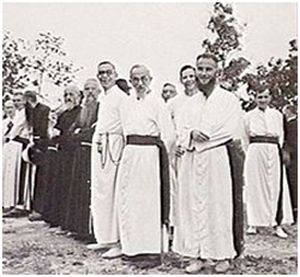
Roman-Catholic clergyman at the liberation of Kuching on 11 Sept.1945, Wikipedia
“21 August. Monsignor was summoned by the colonel.” Colonel Suga still seems to be in power and apparently trusts the Catholic leader of Batu Lintang. And the bishop is possibly thinking of the Catholic Mission of Japan? De colonel explains the Japanese emperor wants peace, but that there are army commanders who want to continue fighting, perhaps also officers in the camp. In that case he will be needing the help of the British, Australian and Dutch military. The bishop advises to bring this before the camp heads. Sugo also tells about the atomic bombs. One of them hit his birthplace [Hiroshima].
Japanese gifts
The colonel also informs the bishop that Australian planes with food will arrive. Everyone will have to stay inside, except for the camp heads. With the women the camp heads will be Mrs Adams and Mother Sophie. They will collect the parcels and take care of the distribution. The diary continues: ”No Australians to bee seen, but the Japs supply. ”Obviously they want to make a good impression and they come with clothes: klamboes [mosquito nets], shoes, white textiles, coloured knee stockings. “The Clarissa nuns end up with 7 pairs of orange and red socks!!”
First dropping
On 29 August, fourteen days after the Japanese surrendered, the first 30 Australian crates on parachutes arrive (after a warning letter was dropped). They do not fall on the white letters the colonel had placed at the main office, but next to the women's barack from the Sisters of Pontianak who just hung out their laundry. ”Every time loud cheers went up when something was dropped and the pilotes waved back.” Lovely white bread, milk, butter, cheese, chocolate, soap, tobacco, cigarettes, etc. etc. And thirty boxes with women's clothes. With one accord it was decided to give the food to the British soldiers. “They had been through so much more hardship than we had“ (p. 132).
Queen's Day
The Sisters can have a real Queen's Day now on 31 August. At half past ten everyone gets a slice of bread with butter and a cup of cocoa. An orange bow in their hair and during singing of the Wilhelmus [national anthem] all stand to attention with their slice of bread held upwards. At 6 o'clock Mother returns home. There is a solution for the transition phase. The final decision remains with Suga, but all requests have to be made with three European colonels. From Australia an Australian boss is on his way. Not everybody agrees to this. Many inhabitants in the camp would have preferred a quick Australian invasion. But the writer thanks God that no accidents have happened. On 1 September the comittee that distributes the boxes with clothes, gives the nuns a couple of black coats, four underskirts and six pairs of house shoes. As well as the other Mothers, Mother Sophie refuses the fine women's clothes.”And the ladies were so happy!” (p.133).
Parachutes
The Australian crates are between two planks tied to a parachute. On 2 September there are 23 parachutes, on 4 September 44, brought by flying-boats and on 7 December even 51. One of them becomes defective and the crates crash into the roof of a ‘bilik’, leaving an Englishman deadly wounded. The Sisters manage to get hold of a few parachutes, “22 m circumference and 3.5 m radius, green and white.” They come in very handy “because our clothes are terribly worn.” Meanwhile a couple of nuns have visited the British hospital. The soldiers are in a bad shape. The care for them has been pretty miserably so far. “No wonder so many died.” Sister Aline and Veneranda are called to help them. They are picked up by colonel Suga's chauffeur. “Times are changing!”
Transfer

Camp commander Tatsuji Suga with sergeant Thomas Eastick (left) and lieutenant-colonel A. W. Walsh (center) on 11 Sept. 1945. Wikipedia
On 11 September all Japanese have to lay down their arms. At 5 o'clock in the afternoon the Australians officially take over control. There are speeches and cheers without ending. For the first time the writer now openly mentions the radio that was hidden under a kitchen table in the British camp. In the drawer were papers which were always inspected by the Japanese. In order to get power, petrol was tapped from the Japanese cars, later on there had to be pedaled to charge the dynamo. The barbed wire and the line for the laundry doubled as antenna's. The diary mentions the suicide of colonel Suga on the island of Lebuan on 17 September. He had is throat cut by his boy and lived for another 20 minutes. This way he escaped conviction. The Sister looks at this with a Catholic pair of glasses: “We were all shock ... So many times he talked with Monsignor about our Holy Religion. Who knows if he did not abhor his actions and repented during those 20 minutes?” Two days later the bishop also declares this vision to a prominent Japanese, together with a list of all ‘Japs’ who were good, not the bad ones. Such one-sided list probably will have been a slap in the face to some of the interned.
11. Return

Labuan Beach (ca. 1950). Coll. Han Kian Lim
Lebuan
The Sisters of Sambas and Pemangkat are flown to Lebuan on 22, 23 and finally 28 September. “We live here in tents on the beach. Sometimes the car even drove through the water.” (p. 136) For everyone there is a camp-bed ready, twelve in a tent. The food is very good. The doctors help everyone recover as good as possible and prescribe rest. There also is a small chapel, but constantly crowded as if it were Perpetual Adoration. At the beach camp they are informed now that the cruel camp docter Jamanoto was giving orders from Tokio on 17 August to poison all women and children and to send the men on a death march through the jungle and kill them. The liberation had been just in time. Jamanoto is sentenced and shot. “How the good god protected us wonderfully” (p. 137).
Bersiap
A second frightening message arrives on December fom Mr. Dr. Scholts from Bandoeng, now on his way to Australia. On 2 October he was assaulted in his home by Indonesians and chopped in his head and body. He was dragged accross the street to the morgue, where he played dead. When found out that he was alive, he was brought to the hospital, where he recovered miraculously quick. “One can not hope for the rebels ever to be in control of power”, the Sister sighs (p.139). [Bersiap is a violent period in history after the Japanese surrendered and Indonesian groups started fighting for independence from The Netherlands, ed.]
Going home
On 8 December the Sisters sail on the ‘Willem van der Zaan’ to Pontianak. The rough sea and the changing over into the prauwen [type of canoes], which almost hit the rocks, makes their arrival a hazardous adventure. Moreover, elsewhere on Bornea in Ketapan, uprising brakes out. The house of the Sisters in Pontianak is undamaged and welcomes them. Also there is the reunion with Sister Auxilia, ‘still in her worldly clothes’ (p. 140). And finally, on 18 December at half past eight the 26 nuns get into two trucks to be brought to the Missions in Pemangkat and Sambas. Nine of them stay in the coastal town, the others travel on to Sambas. The priest and the friar have already been there for a week. Church bells ring. It is absolutely crowded with people, Catholics and non-Catholics. Among the first a new inspector, Mr Van der Schoor. “Shaking hands, asking questions and telling stories, consolating for their losses, etc.” (p. 141).

Students at the Mission welcome ‘Muder’ [Mother] (possibly Mother Chantal, in 1939). Coll. Han Kian Lim
At last
The house of the Sisters, hospital and school are cleaned and refurbished more or less. The number of sick and pupils increases. New Sisters are applied for in Etten, to replace the dead and the ones who were sent to Holland. In March there is a rumour of uprising against the Europeans, and the rectory and Sister's house are being guarded. On 30 May, the day of the first Holy Communion of 16 boys and 9 girls, the hospital is guarded again. Later on the police apprehends a few ‘instigators’. On 16 June Mother Sophie celebrates her birthday and she welcomes Monsignor van Valenberg and another high guest, baron and Jesuit Van Voorst tot Voorst from Java. In June there is a dispute with the inspector of education and in July with the Mission, which is allowed to open a Protestant hospital in Bengkajang. In short, Catholic life in Sambas returns to its normal course again. More or less. The diary ends with a word for the readers, who are also considered to be benefactors: “ With new courage we return to our cut off work, and with the support of your prayers and gifts, we hope to advance quickly, so within a couple of years nothing can be noticed anymore of that lamented war.”
Note: The Congratation of De Zusters Fransiscanessen van Etten
The religious congregation of ‘De Zusters Franciscanessen van Etten’ has been founded in 1820 by Marie Raaymakers (1781-1867). In the Catholic village of Etten the Sisters set up their own boarding school for girls and assisted in the countryland school. Their work was spreading over the provinces of Brabant and Zeeland, often on a request of the local vicar. In 1922 the Sisters started to devote themselves to nursing and social care as well. Finally they engaged in mission work, starting with The Sint-Franciscusklooster in Sambas (1924-1971). Soon followed the Sint-Theresiaklooster in Pemangkat (1929-1967).
Sources
- ‘De Zusters van Etten in gevangenschap en in het Concentratiekamp der Japanners op Borneo’. ('The Sisters of Etten in emprisonment and in the concentration camp of the Japanese on Borneo')
- Wikipedia about Batu Lintang and about the Franciscanessen van Etten
Continuation Internment
In the beginning the camps were enclosed town parts. Also about 160,000 civilians from Holland or elsewhere in Europe stayed outside the internment camps. Their life also wasn't free of hunger, humiliation and oppression. European women also were forced to work as ‘consolation girls’ for the Japanese and Korean troops. Men usually were, as prisoner of war, interned.
Thousands of men were forced to work in Sumatra ('Pakan Baroe') and Birma/Siam (‘River Kwai’) to build the railways through the jungle. 3,000 Dutch lost their lives during this forced labour at the Birmese railway, 1,000 in Sumatra. Many thousands romusha's also lost their lives.
42,000 colonial military men and women, white and coloured Dutch, Surinams, Moluccans and others were imprisoned as prisoners of war in the Netherlands Indies (20,000 British civilians and 50,000 prisoners of war on the Maleisian peninsula, 27,000 French in Indochina). From the occupied regions in East-Asia in total 68,000 prisoners of war and civilians were transported by ships to other parts of the Japanese Imperium, to China, Taiwan and Japan, some to Nagasaki (see speech Han Bawits and memories by Ronald Scholte in Stories). During the transports at sea thousands lost their lives by lack of air and food, and especially by attacks from the allies. The ships also carried weapons and couldn't be recognised from the air as prisoner transports. An notorious transport was that of the Junyo Maru. All fifteen ‘hell ships’ had a name ending on Maru.
On 16 September 1944 the Japanese ship Junyo Maru with over 6,000 passengers left Tandung Priok, Java. 4,200 of them were Javan forced labourers, ‘romusha’. The others were Dutch, Surinam, British, Australian and American prisoners of war. On 18 September British submarine HMS Tradewind torpedoed the ship. It sunk and only 880 persons survived. It would turn out to be the third biggest shipping disaster ever. Among the drowned were about 1,000 KNIL-men, four of them from Surinam. The major part of the survivors were put to work at the 'death railway' on Sumatra.
Most memories of the Japanese occupation of the Netherlands Indies have been written down by civilians from the internment camps. There were kept, despite the prohibition, many diaries, as for instance the camp notes of prof. dr. I.J. Brugmans.
Sources:
Images of the Japanese occupation of Indonesia. Personal testimonies and public conceptualizing in Indonesia, Japan and the Netherlands. Editor: Remco Raben Waanders-NIOD 1999.
Information Broeders van Huijbergen, prior friar Eduard Quint
Data private collection John T.S. Brouwer de Koning version 5.3
www.go2war2.nl
www.cofepow.org.uk/remembrance
Pictures: www.museumverbindingsdienst.nl/leven3
15 August and the war in South-East Asia
Commemoration 15 August 1945 Foundation
Why commemoration on 15 August?
The 5th of May is the day for the annual official commemoration of the liberation from the German oppression. But when the Germans capitulated on 5 May 1945, the Japanese oppression in the former Netherlands Indies still weighed heavily upon all the people living there. To the Dutch from this former Indies therefore the date of capitulation of Japan, the 15th of August 1945, and with it the actual end of the Second World War, is the turning point in their history.
Unlike in Holland, the date on which the oppressor capitulated brought no liberation. When Japan surrendered, no allied forces were in the Netherlands Indies yet. The Japanese soldiers weren't allowed to strive for the Japanese goals anymore, but were ordered to keep rest and peace until the allied forces could take over.
But two days after the capitulation of Japan, an influential group of Indonesians decided to declare the independace of the Republic of Indonesia, independence from Holland and independance from Japan. As a result of this the Indonesian forces tried to do everything possible to lay their hands on the weapons of the Japanese army, in order to prevent the Dutch to return to their former power over the colony; the start of the independance war was a fact and went hand in hand with terrible violence.
So, for the Dutch in the former Indies the 15th of August 1945 didn't bring liberation, in fact it marks the date of the beginning of the definitive end of the Netherlands Indies they'd grown up in, lived in, worked in and suffered in during the war. Many of them blamed - and still sometimes blamed - the Japanese for the loss of their home country.
Every day the 15th of August is the day on which all these far-reaching events for the Dutch in South-East Asia and the people who died because of this, is commemorated.
What caused the Japanese agression and what were the consequences?
Few people dwell on the fact that Holland in the 19th century gave an important contribution to the metamorphosis which happend to Japan, that is, from a from the outside world secluded country to an internationally important industrial power. Among other things Holland tought Japan a lot on shipbuilding and thus enabling Japan to become a formidable navel force.
By the strong industrialisation Japan was confronted with the fact it hardly had any essential commodoties. Looking at the western powers which supplied themselves around 1900 through their colonies (The Netherland was fighting in the Indonesian archipel for the rich oil supplies in Atjeh), Japan had an eye on Manchuria, where also Russia wanted an interest however. This resulted in the Japanese-Russian war which was mainly fought at sea and was won by Japan in 1905.
With this feat Japan put itself on the world map. But the western powers didn't allow Japan to annex Manchuria; though they did agree for Japan to colonise Korea and Taiwan (Formosa).
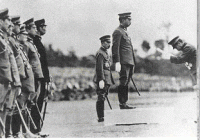
Picture: www.sh15aug1945.nl
This belittleling of Japan by the west was an eyesore to the Japanese military. After the death in 1912 of the Japanese emperor Meiji, under who's government Japan developed industrially, his physically and mentally weak son becampe emperor. During his weak governement, which is called the Taisho-period in Japanese era counting, the military arranged his son Hirohito, and grandson to the glorious Meiji-emperor, was raised and trained from child on in a strong military way. Though Hirohito didn't have a martial appearence, he turned out to be intellectual military gifted.
When Hirohito in 1926, after his father's death, became emperor - the Showa-period - the military seized the opportunity to gradually mold the Japanese state to their will. Eventually the result was a military dictatorship, under which the Japanese civilians, by means of indoctrination of self-sacrificing for the emperor, would groan until mid 1945. The indoctrination even went this far that everyone was expected to give ones life for the emperor. One of the results was that many military men didn't repent for the acts of war and atrocities committed in name of their emperor.
In 1931 the Japanese army succeeded, by a provoked 'incident', to annex Manchuria and in this manner as yet obtain the 'rightful prize' of the Russian-Japanese war. After this happened, and the international community protested but stayed idle, their eyes were turned at China. Also the western powers were extanding their influence in China - in Shanghai there was a British, German and French enclave and the British tried with the import of opium to tackle the weak Chinese gouvernment. But Japan wanted to be 'Asia for the Asians'.
In 1933 Japan deliberately left the Nations Union. In this way it withdrew itself from the international fleet treaties, by means of which the international community tried to block the expansion of the Japanese fleet. Japan now planned a very strong armed force, and executed this. It built the heavy cruisers which were 30% larger than their probable adverts, their super battleships even almost 50%. The new Japanese torpedo was almost twice as big, with a three times larger range and it had no visible bubble track. The army, in the mean time hardened in years of campaigns, specialised in jungle war fare; for which purpose an effective gun was developed. The Mitsubishi fighter plane, the 'Zero', was to be a great surprise in the first year of the war to the allies because of its manoeuvrability.

Despite this military superiority the advance started in 1936 in China stagnated, a thrust inland and the moved capital Tsjoengking failed to occur. Despite more landings and mass-executions like the 'Rape of Nanking' - where hundreds of thousands of civilians were murdered in a horrific way - the army and navy had little successes to report to confirm their heroism.
To free themselves from this pressing situation the Japanese military decided, with the knowledge of emperor Hirohito, to control entire South-East Asia. The first step of this Nanjo-plan was the occupation of some strategical islands south of China in the spring of 1939. Because of the alliance with Germany next free entry to French Indo-China in September could be exorted from the collaborating Vichy-government in France. This led to negotiations with the United States, which threatened with an oil-boycot when China and Indo-China weren't vacated. In the mean time Japan sent a delegation to Batavia to arrange the supply of oil from the Netherlands Indies. The rejection end June 1941 by the Indies Gouvernment and the oil-embargo from the United States in August 1941 were explained in Japan as a conspiracy of what at that time were called the ABCD-countries (the Americans, the British, the Chinese and the Dutch).

This caused the daring plan to, with an attack on Pearl Harbor, eliminatin in one blow the entire American fleet in the Pacific, after which the passage would be free to Malakka, Singapore, the oil-rich Netherlands Indies, the Philipines and even Australia.
On 7 December 1941 the planes from the Japanese navy bombed Pearl Harbor and with it started the war in the Pacific. The Japanese attack was a great succes, also because in the days after the attack the Japanese airforce destroyed half of the American bombers in the Philippines and sunk the British battleships at Singapore with torpedoes and bombs. Indeed within a few weeks Japan conquered Malakka, Singapore, the Netherlands Indies and the Philippines.
The battle was only short because the allies - among them the Dutch - completely underestimated the power, the technical equipment and the tough perseverence of the Japanese military system. In the Netherlands Indies the gouvernment also hadn't taken into account that the local population at first saw the Japanese as 'liberators' and would welcome them. On 15 February the Dutch fleet was defeated in the Battle of the Java Sea and on 8 March 1942 the Royal Netherlands Indies Army (KNIL) capitulated.
The Japanese policy concerning the Europeans
Because of the quick surrender of the allies tens of thousands of prisonors of war fell into Japanese hands. The Japanese soldiers were indoctrinated never to surrender themselves, but litteral fight till their death. Therefore the showed little respect to the allied prisoners and at first didn't know what to do with these large numbers of prisoners of war either. Soon was decided to use these prisoners as forced labourers. It started with loading and unloading of ships, next the building of airfields (for instance in the Moluccas and on Flores) and of railroads (for instance the Birma-railway and the Pakan Baroe-railway), and eventually also the work in the mines and shipyards in Japan.

With the capitulation on 8 March 1942 the Japanese army on Java made almost 90,000 prisoners of war: 67,000 KNIL-military men and women and almost 22,000 British, Australians and Americans. From the KNIL-men 9,200 escaped and 15,000 local people were recruited al Heiho aid-soldier to the Japanese army. Eventually almost 43,000 men were imprisoned, among them almost 5,000 local military men who stayed loyal to the Netherlands Indies.
The circumstances under which thes prisoners of war were put to work were, as well as for the housing in the camps as for food and health care appalling. There also was a reign of terror in the camps, where a persons life didn't count as much. From 8 March 1942 until 15 August 1945 about 8,500 KNIL prisoners from the Netherlands Indies died (3,100 at the Birma-railway; 1,000 at the Pakan Baroe-railway; 3,100 at the torpedoeing of the prisoner ships - just only the sinking of the Junyo Maru cost 1,600 prisoners their lives plus about 4,000 Indonesische romusha's - , 600 at the building of airfields etc. and 700 in the camps in Japan). From the Dutch, Britisch and American prisoners of war one in four or five didn't live to see the end of the war.

Between mid 1942 and the end of 1943 gradually also all Dutch civilians were interned. Also the Indo-Europeans, who's ancestors were whites for more than 50%, had to share this fate. In fact the Japanese wanted to make the Dutch 'invisable' for the native population by interning them. In total they were about 100,000 people, 33,000 men and boys, 67,000 women and children. The age limit for internment of boys in men or boys camps gradually sunk from 15 years to 10 years (see also poem of Govert Huyser - it didn't happen everywhere because in some camps mothers successfully resisted. Also the transport from girls to brothels was successfully blocked in some cases by mothers. Still in early 1944 girls were transported to brothels).
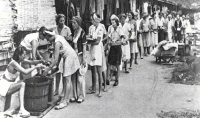
In the beginning many internments camps were only strictly shielded parts in town; in 1944 the occupants of a few hundred areas were concentrated and crammed into some crowded barrack-camps. During the years of war also food supplies and hygiene worsened. Also the brute attitude of the Japanese and their accomplices (Koreans and Indonesian aid soldiers or Heiho's) provided an atmosphere of constant fear.
At the end of the war it turned out about 16,800 civilians died, comparatively more men than women and children.

For those with Indonesian blood who could stay outside the camps, the situation often was evenly precarious. Because of the breadwinner usually being interned as prisoner of war, many families were deprived of an income and the women had to find out for themselves how to make a living. Also they were subject to the arbitrariness of the Japanese masters, among it forced prostitution.
The mutual misunderstanding of each others cultures had in many situations devestating effects. The compulsary bowing equalled the compulsary greating in the army and wasn't meant as nagging. In the Japanse army hitting, heavy physical punishment and even putting to death, were normal rules of discipline. In the eyes of the occupier beating up was a humane punishment, and jailing a bigger disgrace because it caused more loss of face. When you had to be put to death decapitation was more honourable than a bullet which was more honourable than bayonetting.
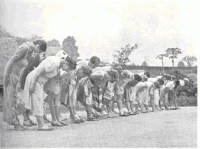
The 'humane' punisment of beating and flogging could happen to anyone, any Japanese could do this to someone. It could also happen to an innocent person: if the 'guilty' person wasn't found, soon someone else was caught or an entire group was punished. For the prisoners of war these punishments were already hard to swallow, but for the women, young boys and girls and old men this was almost even more horrific. Many of them suffered from psychological damage. The recovery from it - if possible - still went on many years after the war.
A systematical resistance was almost out of the question. But there have been small groups everywhere who manly tried manhaftig to give the Japanese a hard time. Because the Japanese were convinced - wrongly - that behind the resistance was a strict organisation with a strategic plan, they tried everything to eliminate this resistance. Many of these groups have been rounded up by the Japanese military police, the Kempei Tai, and the persons involved had, during their 'interrogation', endure the most gruesome torturing.
Almost none survived. Also many innocent lost their lives this way, especially on Sumatra and Borneo. One of the reasons why the resistance and guerilla units often didn't stand a chance, was the passive attitude from the native popluation. Part of this population welcomed the new authority, especially in the beginning. The sympathie of the population for the Japanese gradually declined though, especially from 1944, but the Kempei Tai had established a cunning 'blabbing' systeem which left the population no way to go.
Political developments outside the camps
Shortly after the capitulation of the KNIL here and there an Indonesian flag waved and the national anthem was sung. But already on 20 March 1942 these expressions were prohibited by the occupier. The striving for autonomy for Indonesia was smothered professionally. The recruiting and training of Indonesians for the Heiho aid-army and the PETA volunteer-corps was, as seen by the Japanese, exclusively meant to support the Japanese war efforts.
It wasn't anymore 'Asia for the Asians', but 'Japan the light, the protector and the leader of Asia'. The founding of many sorts of federations was ordered: for all Moslems, all Chinese, Arabs, and also for the (yet) free Indo-Europeans. Also there were federations for all sugar factories, shop owners, merchants, journalists, doctors and chemists.

Rice distribution was introduced and the exclusive sale of agricultural products to Japan. Private estates were expropriated and controlled. Prices, salaries and rents were lowered and frozen. All schools were requisited.

In 1942 the Keibodan (aid police)was established, the Barisan Pemoeda Asia Raya (great-Asian youth corps), which later fused into the Seinendan (military youth movement). Als the Tonarikumi system was introduced for sectioning the kampongs and dessa's in an Aza (or neighbourhood). This way the Japanese influence could penetrate deep into society.
Prominent Indonesians were ordered in December 1942 to design an umbrella organisation the 'Poetera' (Poesat Tenaga Rakjat, or center of the peoples strength) to bundle to peoples activities and cooperate with Japan. This umbrella organisation at first was exclusively meant for Indonesians and had an Indonesian signature; a year later it would be transformed in an organisation of Japanese design: the Djawa Hokukai (National Peoples Movement).
Many odd jobs for Japan were carried out by the organisation. Recruitment for PETA, Heiho, Keibodan and Seinendan (army, aid militia, aid police and youth) were forced by the Tonarikumi system; indicating for romusha forced labour was intensified, actions against non-loyal Indonesion Dutch started. Also compulsary rice supplies were enforced, harvesting and forced cultivation were supervised; the Seinendan searched for hidden food supplies. The cultivation of Djarak-plants (an oily ricine-plant) was compulsary for the production of motor oil for the Japanese planes. In 1944 a compulsary saving action started, Indonesians with a saving account book had to hand over their credits.
The recruitment of romusha's took place at an unprecedented scale. Most of them were forced to work on Java and Sumatra for the building of airfields and railways. Also for the cole mines in Borneo, the nickel production in Celebes and for airfields in New-Guinea. The romusha's had to work under appalling circumstances (even worse than the prisoners of war who were forced labourers) and died by the sackful. According to Indonesian estimates from 1951 during the war some millions of romusha's have been deported and many hundreds of thousands died.
Despite the many meetings from a large number of organisations from the Djawa Hokukai economy worsened. After the internment of the Europeans and the increasing Japanese forced regulations cultures dwindled, and public health worsened. The prices in 1944 during the Japanese occupation were a sixfold of the prices in 1938 under the Netherlands Indies Gouvernement. Rice rations already were lowered and food riots started. There was no more clothing available. Gold, silver and jewelry had to be handed over. Car tires and oil were only available to the army and the authorities.
In July 1944 48 Heiho's were shot because of objection to labour, and also at the end of 1944 still some executions were carried out. In January 1945 a revolt started in Blitar among the PETA; during the fights 68 Indonesian military died. The population of rich Indonesia were weighed down during the last year of war by an enormous shortage of rice and other necessities, like textile and fuel. There was openly criticism on the tyranny of the occupator, its inhuman treatment of the romusha's. This could happen most of all because more and more information seeped through which indicated a lost war.
Early 1945 Japan proposed to replace the Hokukai by the organisation Angkatan Baroe: the New Conscription; in May 1945 the first serious actions were undertaken with a promise of premier Koiso of September 1944 (eight months before!) for more independence. The red-white flag was allowed, the name Indonesia was introduced, commissions made proposals and organisations prepared for the national cause.
The war scene, the capitulation, but no peace
While the Japanese were lord and master of the Indies Archipel, the fights with the allies, and specifically with the Americans, happened on the edges of the archipel. Because the advance of the Japanese to the south in May and June 1942 already stagnated by respectively the lost battle in the Coral Sea and the battel of Midway, and this news was known in the internment camps through illegal radio's, the prisoners had the idea the war would soon be over. They couldn't be wrong more.
The Japanese defended the conquered territories with everything possible at the cost of enormous losses, also on American side. Therefore the American supreme command decided not to liberate the Indies first, but to push through via two attack routes as quickly as possible to Japan itself. The western route went along the Phippines, the eastern route along the islands in the Pacific. Small islands became of enormous strategical importance because they could produce airfields from which bombers could shell the next target and finally Japan.

One of these islands, the notorious island of Iwo Jima (from the picture where 5 marines planted the American flag) was conquered in four weeks on the Japanese occupiers, during which the entire Japanese forces of 22,000 men fought till their death and the Americans mourned for almost 7,000 dead and 19,000 wounded. These incredible huge losses, which also happened during the conquering of New Guinea and the Philippines made the American supreme command realize that an invasion of Japan itself would be a massacre never seen before. When at that moment the first atomic bombs were operationally available, it was decided to deplore the weapon. Thus on 6 and 9 August 1945 the cities of Hiroshima and Nagasaki were razed to the ground. The number of victims at that time (and also later as a result of radiation) is many times less than the number of victims that would have fallen during an invasion. Also Dutch prisoners of war fell victim. Ronald Scholte (1924) survived the attack on Nagasaki (see Verhalen).
The shockeffect was so that the Japanese emperor, against the will of the army, decided on 15 August 1945 to capitulate.


For many people in the internment camps, but also for those who weren't interned, the capitulation was just in time. The health situation was that bad (dysenty, malaria, hunger-oedema), the number of dead would have been considerably larger if the war had continued for a couple of months.

Because of the interned being cut off from the outside world during the years of war, they weren't able to observe nationalism in Indonesia had taken root in large parts of the population. When the Dutch, after the capitulation of Japan, believed to continue their lives frome before the war, they were confronted with the fact that on 17 August 1945 the Indonesian nationalists Soekarno and Hatta had proclaimed the independant republic of Indonesia.
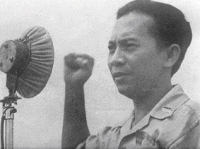
Thereupon Indonesian forces ('Pelopors' or front fighters) came into action, who set out to murder the Dutch and their Indo-European 'followers', in such a way the colonial gouvernment couldn't be restored. In this bitter, confusing and bloddy period, the 'bersiap' ('bersiap' is the Indonesian command 'attention'), meanwhile the here and there landed English and Ghurka's tried - together with the Japanese - to protect the Dutch and evacuate them. In the cities Bandoeng and Semarang it even were the local Japanese commandanders (respectively general Mabuchi and major Kido) who effectively protected the Dutch against the Indonesian forces, despite the fact they were in favour of independance.
Many Indo-Europeans and Chinese, who stayed during the war outside the camps, were now interned by the Indonesian police to protect them against those forces who wanted to butcher them together with the Dutch.
Though the Dutch gouvernment end 1945 had returned to Batavia (Jakarta) and some parts of the country were functioning under Dutch administration again, the Indonesian 'gouvernment to be' was in command in many regions.
Holland didn't as yet want to face reality, that Indonesia had become an independant state. Despite the fact the Dutch had just been going through many years of war and oppression, a force of 100,000 men was sent to the Netherlands Indies. [Ed.: At the moment the number is considered to have been 150,000, also mentioned in the tv documentary 'Nederland valt aan!' (The Netherlands charge), of 21 July 2012.
After many failed negotiations and two military actions (the so-called 'Policing Actions' of July 1947 and December 1948), which were forced to stop within ten days because of external international pressure, Holland recognized in 1949 the legitimate existence of the Republiek of Indonesia. In December of the same year authority was handed over, and came an end to 350 years of Dutch involvement in the Indonesian archipel.

A huge stream of repatriants from Indonesia to Holland was the result. The at that time common word 'repatriant' though passed over the fact that many of them never had set foot on Dutch soil and that the arrival in Holland and the 'loss of the Indies' brought about emotional shocks, from which many of them never completely recovered. Many of the repatriated had to overcome many problems in finding a new way of living, for their stories about what they had went through was no attention and when applying for job they often met explicit, unreasonable distrust.
And than there were the Moluccans and the Indo's who, after fifteen years of uncertainty about their existance, still had to take refuge in a cold country which they knew only from stories.
And finally the youngest, who felt lost for years in an incomprehensible and indistinct whirlpool; who didn't know safety in their youth, but only uncertainty and fear and who often carried this shortage for many years with them.
In another way such shock awaited also the military men and women of the KNIL and the Royal Forces, who did their duty for Gouvernment and Queen, and were treated during the following years many times on emotional and often injust criticism on their 'dirty' war.
Therefore the commemoration on the 15th of August has its own comprehensive meaning to the Dutch-Indies community in Holland, a meaning which never can be replaced by the commemoration on 4 and 5 May.
Text: Hans Liesker and Peter Slors
Commemoration 15 August 1945 Foundation
Netherlands Indies (gays)
A still fairly unknown chapter is the position of gays in the Netherlands Indies in the thirties and fourties of the 20th century. Marieke Bloembergen published about them in 'De geschiedenis van de politie in Nederlands-Indië. Uit zorg en angst.' (The history of the police in the Netherlands Indies. By concern and fear. (Boom/KITLV, November 2009). A black period was the raid on gays of the colonial elite between November 1938 and January 1939. The raid was hatched by the Javabode, the main editor being a sympathizer of the NSB (Dutch national socialist movement), and the Christelijke Staatspartij (Christian State Party). Also the Resident of Batavia and the Head of Police, Fievez de Mailines van Ginkel, was a victim. The most famous of the 223 arrested lived on Bali. He was the renowned German artist Walter Spies.
Walter Spies
After his arrival on Bali (1927), the Russian born, versatile German painter and artist Walter Spies (1895-1942) became the center of a 'Artisten Coöperatie' (artists cooperative) named Pita Maha. The cooperative comprised Balinese artists. Spies had international fame and was visitied on Bali by celebrities like Charley Chaplin, the cultural anthropologist Margaret Mead, the writer Vicky Baum and the film-maker Von Lessen. The last three produced important works on Bali.

Walter Spies (picture: adhidharma.net)
In December 1938 Spies was arrested because of the 'unbridled sensuality' in the group he was the center of. His arrest was part of a witch hunt against gays (or suspected gays) in the Netherlands Indies. The Resident of Batavia and Head of Police, Feviez de Malines van Ginkel and many other leading figures were run in. The hunt was an echo of the Ries-affair in the Netherlands. The Jewish senior executive L.A. Ries, was in 1936 falsely accused of sexual acts with a minor (under 21) and had to resign. The affair fitted within the political conservative climate of the depression, during which time nazi Germany was a threat and inspiration. Also in the Indies there was a depression and a threat of war from vanuit Japan.
In his prison cell Walter Spies was allowed to continue painting and compared his emprisonment with the shaking of fluids 'before use'. Balinese friends organised a gamelan concert near the prison. In his cell in Surabaya he painted one of his best works: 'The landscape and its children'. After eight months he was released. A second arrest followed in May 1940, but for other reasons. Spies was a German and, from the occupation of the colonial motherland on, belonged to a enemy nation. He was interned in camp Ngawi on East Java and in camp Kotatjane on Sumatra. This time he wasn't released. Also he wasn't allowed to have his painting gear brought over from Bali.

SS Van Imhoff (picture: photoship.co.uk)
Because of the Japanese threat early 1942, together with probably 477 other German prisoners, he was transported on the ss Van Imhoff (KPM) to the British Indies. On 19 January, a day after departure, the ship was attacked by a Japanese bomber aircraft, not far from the island of Nias near West Sumatra. The captain didn't want to free the interned just like that. Together with the crew, the soldiers and guards, about 140 men, they left the vessel in the available rescue boats and abandoned the prisoners who were in an enclosure with barbed wire in the hold. Only in the very end they were handed out a few wire-cutters. About half of them were able to rescue themselves from the slowly sinking vessel. A surviver, J. Grashoff, saw the boats waiting at a distance of about 500 metres, with a lot of space left in them. A Dutch ship which had responded to the distress signal of the Van Imhoff didn't offer any help when they found out they were German. Of the interned who were able to flee from the ship, a group of 67 arrived after five days on the island of Nas. Walter Spies belonged to the approximately 411 Germans who died with the sinking of the Van Imhoff or in the days afterwards. A Dutch crime of war?
Works by Walter Spies can be seen on Bali in the Agung Rai Museum of Art (ARMA) and the Rautenstrauch-Joest Museum in Cologne, Where also the Walter Spies Society is established.
Sources:
- www.nos.nl/nosjournaal/artikelen/2009/11/14/141109_jacht_op_homos_indie.html
- NOS-documentaire uit 1981 over Walter Spies: Schoonheid en Rijkdom
- www.walterspies.com/walter_spies_biography.html
- www.adidharma.net/features/walterspies.jpg
- en.wikipedia.org/wiki/Walter_Spies
- users.skynet.be/network.indonesia/bart003.htm
- www.nrcboeken.nl/recensie/rederij-koninklijke-paketvaart-maatschappij-wel-en-wee-van-een-indische-rederij-door-a-j-j-
- www.volkskrant.nl/archief_gratis/article624087.ece/Wie_was_mr_L.A._Ries
- www.nieuwsdossier.nl/dossier/1941-01-19 [wrong year]
- Ad van Liempt, De Oorlog. Drama's in de Indische archipel. Volkskrant 5 dec. 2009
Speech by dr. Bernard Bot,
minister of Foreign Affairs of the Kingdom of The Netherlands
15 August commemoration at the Indies Monument, The Hague, 15 August 2005

Picture: www.minbuza.nl
Dear attendance, ladies and gentlemen,
I’m grateful to have been given the opportunity by the Foundation Commemoration 15 August 1945 for making today this memorial speech. To me, as the minister of Foreign Affairs en representative of the gouvernement, it’s a honourable task. But, like many of you, I’m also here as a child of the Indies. Just as with you this commemoration brings to me feelings and emotions, surface today positive as well as negative memories to Indonesia, 5 time zones and 14,000 kilometers away from this place, but emotionally so near. They are the memories you’ll carry the rest of your life, but who don’t have to interfer with an optimistic and forward looking attitude to life. After all, commemorating is, besides remembring, also looking forward.
First the past: with the capitulation of Japan, exactly 60 years ago, there also came an end to the Japanese occupation of the Netherlands Indies, an occupation which brought grief to so many of us. We remember the members in our families and our friends who gave their lives of died during the Japanese occupation. We also remember the countless forced labourers, the Romusha’s, who often died nameless.
After the capitulation the suffering, contrary to what was so dearly hoped for, wasn’t over yet. Right after the capitulation a vacuum of power existed which could only partially be filled by the British. During this so-called Bersiap period many thousands of innocent Dutch-Indies and Indonesian civilians, mostly women and children, lost their lives.
In the years after a painful, lenghty and violent separation of roads between Indonesia and Holland followed. For a great part of the Dutch-Indies community we thus speak about many years of physical and psychological suffering.
For myself, I look back on my time in the camp Tjideng with mixed feelings. Perhaps as a child you’re less quickly touched by the sorrow and the hardships around you, perhaps you take things more easily. But you also grow up very fast. A stay in an orphanage, when my mother was hospitalized, made me streetwise very early.
Probably that’s why this period is still so sharp and vivid in my memory. I vividly remember the internment, the departure of my father to Birma, the koempoelans in the morning and in the evening, the hours of waiting and afterwards the bow for camp commander Soni. I also know you died a thousand deaths when you couldn’t attend the koempoelan because you were ill, because the Japanese could find out with a check. The memory of the hunger is something that, I believe, with my generation lives on strongly in the sense that you won’t throw away easily anything that is still a bit edible.
A small anecdote. We were forced to maintain some allotments supposedly to grow some vegetables. I was ordered to help in a tomato bed. I was very dissapointed when some morning almost ripe tomatoes had dissapeared.
I suspected the boy next door of this evil deed and decided to retalliate. Only, his tomatoes were all still unripe and green. I still ate them which I repented afterwards. It’s wasn’t for long when I felt sick to death and had to confess to my mother what I had done. “Boy”, she said, “you’ll always get what you deserve”.
A lot is written again about the Japanese capitulation. Ofcourse it’s terrible what happened in Hiroshima and Nagasaki. But I also know that war couldn’t have gone on for a bit longer, otherwise we wouldn’t have survived this camp. And for sure my father wouldn’t have returned from Birma and Siam. To me therefor, 15 August is a day with a special meaning.
The liberation, the return of my father, who I didn’t recognise ofcourse when we first met again, the return to Hoalland, are likewise uneraseble memories I’d like to share with you today. The welcome in Holland was something of a cold shower. And I don’t say this because of the cold climate I went to. It was hard to explain what we had gone through. The regular reaction was, that with us in the Indies, at least the sun had been shining, while they suffered from cold during the hunger winter. In shor, nobody in Holland was waiting for that group of Dutch from the Indies. Soon you learned not to talk to much about your experiences, but listen with sympathy to the stories about the war in Holand, the Germans and the destruction camps.
Maybe that’s the reason why we were able to integrate so well and so quickly in Dutch society. Maybe therefore we quickly stuck plasters on all those wounds and picked up our lives. And ofcourse there also were reasons to be grateful. We had survived and at least found a new home. Personally therefore, I’m grateful to stand in front of you, that I like so many of you endured this period well, and have shown you can come out of this ordeal even stronger.
(Living history)
Sixty years, ladies and gentlemen. The distance in time between today and the events in the past is growing all the time. And doesn’t this bring the risk of oblivion, like Mr. Boekholt pointed out two years ago on this occasion? I hope and trust this won’t happen. I think future generations will stay interested in the common past ot The Netherlands and Indonesia. I think our youth is willing to adopt this history, like the students from the Liberal Christian High School adopted the Indies monument and like so many other schools for instance maintain the militairy cemetaries. But to convincingly cherish the history, the past and the knowledge about that past also must be relevant today and in the future for our youngsters.
Winston Churchill once said it like this: the further one is able to look back, the further one is able to see in the future. Indeed: historical knowledge isn’t a superfluous luxury, but the condition for a clear view on the future. And this certainly meant for the relation between Holland and Indonesia. When the Dutch will come in contact with Indonesia and Indonesians, in whatever way, they’ll have to know something about the history of this country, and therefore also about centuries of shared Indonesian-Dutch history. Dutch people, who think they can succesfully go into business or diplomatic channels in Indonesia, without knowing anything about the history, usually come away with a flea in their ear.
When a society wants to meet the future with faith and optimism, it must be prepared to be honoust about the less favourable sides of its own history. Certainly in a time when we in Holland – at work, in the sports cantine and at school – want to bridge the diverse ethnic an religious communities in our country. In the context of this commemoration it means that we dare admit that even after the introduction of the so-called ethical politics the interests of the Indonesian population for most Dutch was at best a second degree item.
Working on a mutual future. That shouldn’t only be the motto within our own society, but als in the relation between Holland and Indonesia. The challenges we have to take up are manyfold, like the battle against intolerance, extremism and terrorism.
Indonesia is important. It’s a driving force behind regional cooperation in South-East Asia. As a secular state Indonesia houses more moslims than any other country in the world, but it’s also the guard of centuries of budhist, hinduist and christian traditions. As such Indonesia has a say in the dialogue between the cultures. During the Dutch chairmanship of the European Union last year therefore, we’ve payed a lot of attention to intensifying the connections with Indonesia.
(Message to Jakarta)
Ladies and gentlemen, to further intensify the relation between Indonesia and Holland, it’s helpful to remove whatever is left of old sores, as far as it’s within our power. Therefore, as representative of our country and as representative of the generation who experienced the pain of the separation, I’ll take a plain today, travel through those five time zones and cover these 28,000 kilometers. On the 17th of August then, I will represent our country at the Indonesian celebration of the proclamation of independence on the 17th of August 1945. I will explain to the Indonesian people that my presence can be seen as a political and moral acceptation of that date.
But what really matters now is that we clearly show the Indonesians our opinion. Already for decades Dutch representatives join the celebrations of the Indonesian independence on 17 August. With the support of the Cabinet I’ll clearly explain to the Indonesians that Holland realizes the independence of the Republic of Indonesia already started on 17 August 1945 and that we – sixty years to date – genrously accept this fact in a political and moral sense.
Acceptance in a moral sense also means that I will join the former expressions of regret about the painful and violent separation of Indonesia and The Netherlands. Almost sixthousand Dutch militairy lost their lives in this battle, many lost limbs, or became victim of psychological traumas, for which, again, was only little interest in Holland.
By the large scale deployment of militairy resources, our country ended up on the wrong side of history so to speak. This is especially wry for all people involved: for the Dutch-Indies community, for the Dutch militairy, but first of all for the Indonesian population.
Ladies and gentlemen, only when we stand on the top of the mountain, we’re able to see the simplest and shortest way up. This also goes for the people who were involved in taking decisions in the fourties.
Only in hindsight it’s clear the separation between Indonesian and Holland took far too long and was achieved by much more militairy force than needed.
This is the message I’ll take with me to. I also fiercely hope for the understanding and the support of the Indonesian community, the Moluccan community in Holland and the veterans of the policing actions.
After all, to keep our mutual history alive, we also need a mutual perspective on our future. Working together for a healthy and safe futer, and for the good relation with Indonesia, will help us to bear even the most painful aspects of our past.
I thank you for you attention.
Sources: www.pelita.nl, www.sh15aug1945.nl and Ministery of Foreign Affairs
Commemoration speech by prof. dr. B. Smalhout
The Hague, 15 August 2004

Picture: www.meervrijheid.be
Today it's exactly 59 years ago the Japanese empire surrendered to the allies. Only at that day came an eind to the Second World War. This war had been so terrible that even today some generations still suffer from the physical but especially also psychological damage they sustained between 1942 and 1945.
In our country there are two groups of people were the sorrow never wears off. That is the relatively small group of jewish civilians who survived the holocaust. They are less than ± 30,000. Over 80% of our jewish population has been murdered by the Germans.
The second group comprises of you, the Dutch-Indies people. You spent an important part of your lives in our former Netherlands East Indies. By much of the progressive media you have been blamed for almost 60 years, having cooperated with a colonial system which, seen in the light of todays views, would be objectionable.
But they forget most of you loved the former Indies as their second homeland. What Holland achieved in that tropical archipal over 300 years, can still be named with honour. Holland led the foundation, in that giant country which embraces over 1/8 of the earths circomference, for what is now the republic of Indonesia.
It is amazing at that time we governed that huge area which already had ± 70 million inhabitants, and developed with a comparatively smaal group of Dutch working there. A group which was seldom larger than 300,000 people! Schools were established, education was stimulated and hospitals were built. An excellent legal system was introduced, in which specific Indies traditions were considered, the so-called 'Adat'.
In Holland at universities there were professorships for Indies law, tropical medicine, tropical agriculture and Indology. Scientists and doctors managed to fight diseases as smallpox, cholera, pest, typhus, beri-beri, dysentery, malaria andn lepra in that enormous archipel. They saved the lives of millions. Even nowadays, almost 60 years after Holland left Indonesia for good, Indonesion law is still partly founded on the work of Dutch jurists. And prominent Indonesians still send their children for a higher education to Dutch universities.
Ofcourse in todays light a colonial system can't be justified anymore. But it is something we never can blame the Dutch for who worked in the Indies. Not even a hundred years ago opinions about this were completely different. Still after-war left-progressive views led to a taboo on the concept of 'Netherlands Indies'. And this is one of the causes the Dutch-Indies community is continuously frustrated by. The reception in Holland at your repatriation after the war was very cool, almost hostile. For many of the completely broke old-Indies people there was hardly human relief. After years in Japanese camps or horrible forced labour in the entire Far East, there was no money for you, no pay of back salary, hardly any clothes, hardly any housing en hardly any compensation.
And also with it is many of you hadn't been terrorised solely by the Japanese, but after the liberation on 15 August 1945 as wel by the so-called 'freedom fighters', the pemoeda's of Soekarno. That was the notorious bersiap-period. The frustration stayed. Because you as an Indies community bore a different culture. Achievements like discipline, good manners, courtesy, politeness, traditions, loyality, respect for and loyalty to the royal house can be found more with you than with the Dutch who don't have an Indies past. This all led to a feeling of not always being exepted. Or in the worst case pure discrimination. In our strongly devaluated education nothing is told anymore about the 300 years of Netherlands-Indies history. Even the word 'national history' is banned. That was, according to our pink-red education experts too nationalistic, too authoritarian and therefore objectionable.
It was also very frustrating the Indies community had to wait over 55 years before our governement allowed to commemorate the 14th and 15th of August as official remembrance days. The same left policy is also the cause why the old KNIL military men and women never received their back salary from the years they were imprisoned. And also that one of the greatest heroes of war, the KNIL-officer Jack Boer never received consideration for a fitting Military Willems Order. In November 1945 he liberated from the Werfstreet prison in Surabaja 2,384 Dutch civilians who were imprisoned by the pemoeda's from Soekarno to be murdered massively. Jack Boer conquered the heavily guarded prison with the help of only 10 British-Indies Gurka's and one old Stuart tank. He saved with it almost two and a half thousand Dutch lives. Jack Boer died in 1993, but his widow is still alive. But until now not even a posthumous decoration can be given.
This is why many of you aren't able to share your experiences with your children and grandchildren. They often hardly know what it's all about. And they even often don't want to hear it. They think it's moaning about what used to be. Because your stories are about a time and a country they can't imagine, because of seriously lacking any historical insight. In my archives are heartbreaking letters from old-Indies people who have, already only because of this, a disturbed relation with their offspring. The consequence is these people often timidly block their past and never want to talk about it again. The same phenomenon can be seen with jewish people who survived the holocaust. They feel their experiences arte too terrible to speak about or they are afraid others might not believe them.
Also there's in Holland the completely wrongly belief that the past should be left alone by now. That one can't live with what's gone. That one should only keep an eye on the future and forget about the rest. That is the most stupid thing to do. Because we're all products from history. One can't build a meaningful future without knowing about the past and taking lessons from it. Therefore knowingly disregarding the subject historiy on schools, what has happen for almost thirty years, is a crime to our younger generation.
Only by knowing what has happened, one can learn to think critical. For example about the sociological riddle that highly developed cultures, nations, like the Germans and the Japanese, could descend to such a low moral level during the war. Only thinking about this, makes it possible to unmask lifethreatening political psychopaths at an early stage and by that preventing large scale calamities. The deliberate oppression by the state of that knowledge seems to suspect the gouvernement is aiming for a young electorate who don't know a thing. People being kept ignorant are ideal for ambitious politics with dangerous ideas.
Therefore I want to impress on you not to conceal your experiences. Tell about them. Publish them or just write them down for yourself, so they won't go lost. You can be proud of what you've done and about what you've survived. You are an indispensible cornerstone in the building of our national history. Like all survivers, both from the Japanese as from the German terror. Only if we've come to terms with those experiences and sublimated them into our self-consciousness, than we can raise the subject of mutual approach, understanding and perhaps even a cautious form of forgiving our former enemies. It is the painful process of growing up from peoples and nations.
In a minute we'll leave for the Indies monument. There we will commemorate in respect the ones who didn't live to experience the joy of the liberation on 15 August 1945. But also you've to proudly realise you're an unerasable part of Dutch history. A history indeed of sorrow and misery. But worth to be told a thousand times over.
Source: www.sh15aug1945.nl
A dark page in the 400 year history of relations between the Netherlands and Japan
(Japanese emperor in The Netherlands)
Experiences of victims during the Japanese occupation of the Dutch East Indies 1942-1945
 Japanese version 1 2 3 4
Japanese version 1 2 3 4Introduction
On December 8, 1941 the American base Pearl Harbor was attacked by the Japanese after which the United States and The Netherlands declared war on Japan. In March 1942 the Japanese landed on Java and after a three month’s battele, the Dutch East Indies were forced to surrender.
Of the approximately 350,000 Dutch the Japanese first interned the men and later on the women and children followed. Cruelty and violence were often typical for the behaviour of the Japanese guards. Especially in the last year of the occupation the internees in the overcrowded and insanitary camps suffered from chronic malnutrition, hunger oedema, dysentery and malaria. Many thousands have died as a result of these diseases.
Although the majority of the Eurasian men were interned as prisoners of war, many Eurasian women and children were able to remain out of the camps. Because of loss of income many of these families got into difficult situations. Forced labour, forced prostitution, torture, chronic malnutrition and diseases took their toll. The Indonesians' behaviour was also increasingly hostile, which culminated in the so-called Bersiap-period (battle of independence) after the Japanese occupation had ended.
After Indonesia's independence, approximately 300,000 Dutch citizens out of sheer necessity left for The Netherlands, a country still recovering from the war with Germany. They left behind over 42,000 deceased.
A survey
Even after 55 years the impending visit by the Japanese emperor appears to evoke fierce emotions among the Dutch who fell victim to the Japanese war. 'The Vereniging van Kinderen uit de Japanse Bezetting en de Bersiap 1941-1949 (Association of Children from the Japanese Occupation and the Bersiap 1941 -1949) also known as the KJBB has, in co-operation with the Province of North-Holland, asked Mr F.A. Begemann to conduct a survey among those who lived in the fonner Dutch East Indies as children during the war.
Thirteen members of this Society were interviewed at length. A report of these interviews was presented to 80 members of the KJBB during their meeting of March 25, 2000. The report was discussed extensively and commented on by those present. These comments have been incorporated in the final report, which is considered to be representative of the opinions of all KJBB members.
During these interviews the participants were not just asked about their views on the coming visit of the emperor, but they were also asked about their personal backgrounds and especially their experiences during the war were discussed at length.
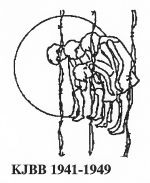
What did they experience as children during that period?
All children, whether interned or outside the camps have suffered hunger during the Japanese occupation. For many of them this has resulted in physical illness but in many cases it has also affected their mental strength. This in part explains why decades later so many of these children are still troubled by their traumatic experiences during the Japanese occupation.
Besides hunger these former children have also frequently experienced violence. In and outside of the camps children were beaten and abused. Frequently children were made to watch others being abused, for instance their parents.
During the Japanese occupation most children were separated from one or both of their parents. Nearly all fathers were interned, including those of Eurasian children. In many cases the children also lost their mothers: temporarily, because of illnes or malnutrition or permanently when they died as a result of the war. In many cases the separation from their parents appears to have seriously affected the development of these children.
Because of the Japanese occupation children were torn from their normal lives. Besides being separated from one or both of their parents most of them also lost their family homes, their schools and their schoolmates. The children who were interned had to adapt to completely new living conditions. Life outside of the camps also changed dramatically, even when just taking into account the loss of regular income.
In as well as outside of the camps the children had to learn how to survive, for instance by trading or stealing food. In war conditions children are often forced to adapt in ways they are not yet capable of in terms of their development. This has resulted in both psychological and physical damage. Many of these children continue to suffer the effects in later life, such as recurring insomnia, nightmares and anxieties. As a result many have had to give up their career prematurely.
After the capitulation of Japan many families were reunited but this was a difficult process. The men returning from the camps often found it difficult to share their experiences with their wives, who had also gone through a lot themselves. The children noticed the change in their parents and how it affected the atmosphere at home. In many cases the parents were unable to help their children deal with their war experiences.
After the Japanese capitulation in August 1945 the struggle for independence in the former Dutch East Indies broke out. This conflict not only resulted in many casualties but it also caused a great number of people to flee the country. The reception of the victims from the Indies was difficult since the Netherlands had also suffered severely as a result of the war in Europe. Their experiences and problems generally fell on deaf ears. This resulted in social isolation for this group of people which in turn has aggravated their problems.
How do the KJBB members feel about the impending visit of the Japanese emperor?
Although opinions on the visit of the emperor among KJBB members differ there is consensus on one point:
It is important that during his visit of the Netherlands emperor Akihito apologises to the victims for what was done to them by Japan during the war. These apologies are required from the emperor himself because the acts of violence have been committed in the name of his father, Hirohito.
Why is this so important to the KJBB members? The arguments turn out to be connected with the years of war:
- The demand for apologies does not stem from feelings of hatred, but from a need for justice
The reason for this demand for apologies is best illustrated by an analogy. A society can only continue to exist if it is based on a system of law, which provides a foundation for social rules. A person who commits a crime denies this system of law and places himself outside of society. He can only be admitted back into society if he recognises his mistake. For by apologising the system of law is reconfirmed.
Mutatis mutandis the same is true for the emperor of Japan. The victims of the Japanese war can only receive the emperor if he acknowledges that Japan has made mistakes in the past and apologises for these mistakes.
There is a second reason why this is important to the victims. The majority of the victims has had to end their career prematurely because of physical and psychological problems. For many of them this has resulted in feelings of guilt and shame. People who can no longer conform to social expectations usually suffer from feelings of guilt even if they cannot be held responsible. The explicit assessment that the blame for the problems of these victims lies not with the victims themselves but with Japan's aggression is therefore very important. - The war has not yet become part of the past
The war in South-East Asia is more than fifty years ago. Then why is this war still not a thing of the past for the victims?
First of all because they are still haunted by their traumatic memories and suffering from various health problems caused by the war. Think for example of a woman who is unable to sleep because of the backpains she suffers as a result of life in the camps. For her the war is still very much a thing of the present.
The past also remains a part of the present because many victims continue to experience Japan as a hostile and menacing nation. By apologising the emperor would distance himself from the past. In doing so he would make it easier for Japan's victims to achieve a sense of closure. - Giving meaning to being a victim
Because of the war with Japan a lot has gone wrong in the lives of its victims. How does one live with the sorrow over what has happened?
For many victims it proved to be important to give a sense of meaning to being a victim. Many use the Jews as a model because they not only commemorate their dead but also warn against new forms of fascism. Driven by similar motives many victims of the war in Southeast Asia try to support forces within Japanese society who try to prevent new Japanese aggression.
Viewed from this perspective it is essential that Japan recognises the fact that in the past things have happened which are unacceptable. By apologising the Japanese emperor will express Japan's desire to distance itself from the past.
This in turn will support the attempts of the victims to give meaning to their war sufferings. - Special attention for children in war situations
In many places in the world armed conflicts are still taking place. In these situations many of the victims are children. This is tragic, because children especially deserve to be protected from violence by adults.
It would therefore be commendable if in his apologies the emperor would explicitly mention the people who were children during the war. It would first of all mean recognition for those who experienced the war as a child, but it would also draw attention to the fate of those children who still today fall victim to violence caused by war.
This is a summary of the publication:
‘Vanuit een behoefte aan rechtvaardigheid – Reacties binnen de KJBB op het voorgenomen bezoek van de keizer van Japan aan Nederland’
(‘From a need for justice – Reactions within the KJBB to the intended visit of the emperor of Japan to The Netherlands’)
NPI/KJBB, April 2000
Additional reading:
The Year 2602 (Children's stories from the Jap camps - in Dutch)
Japanese civillian camps (in Dutch)
Please do feel free to comment on our English translation. We welcome any improvement!
